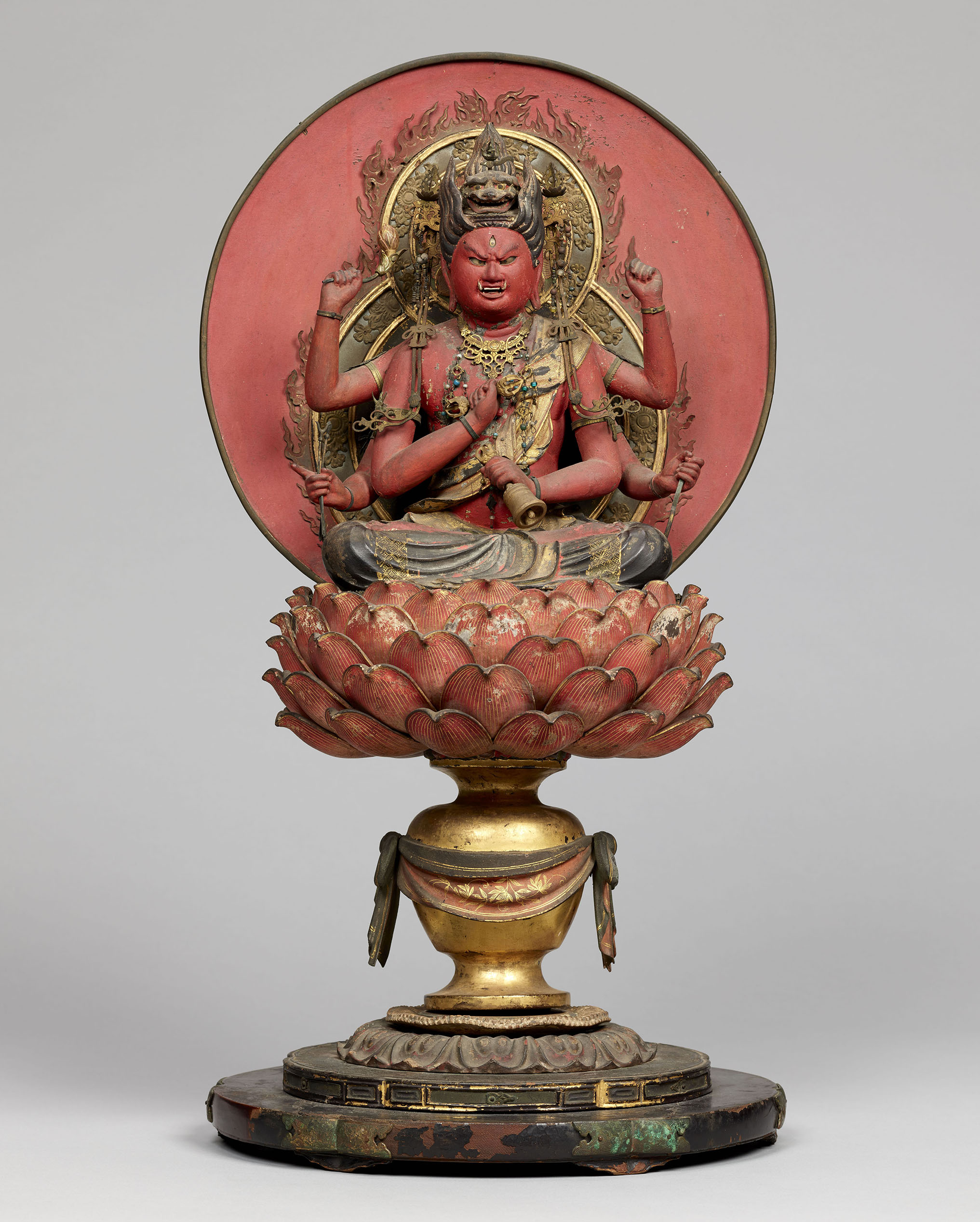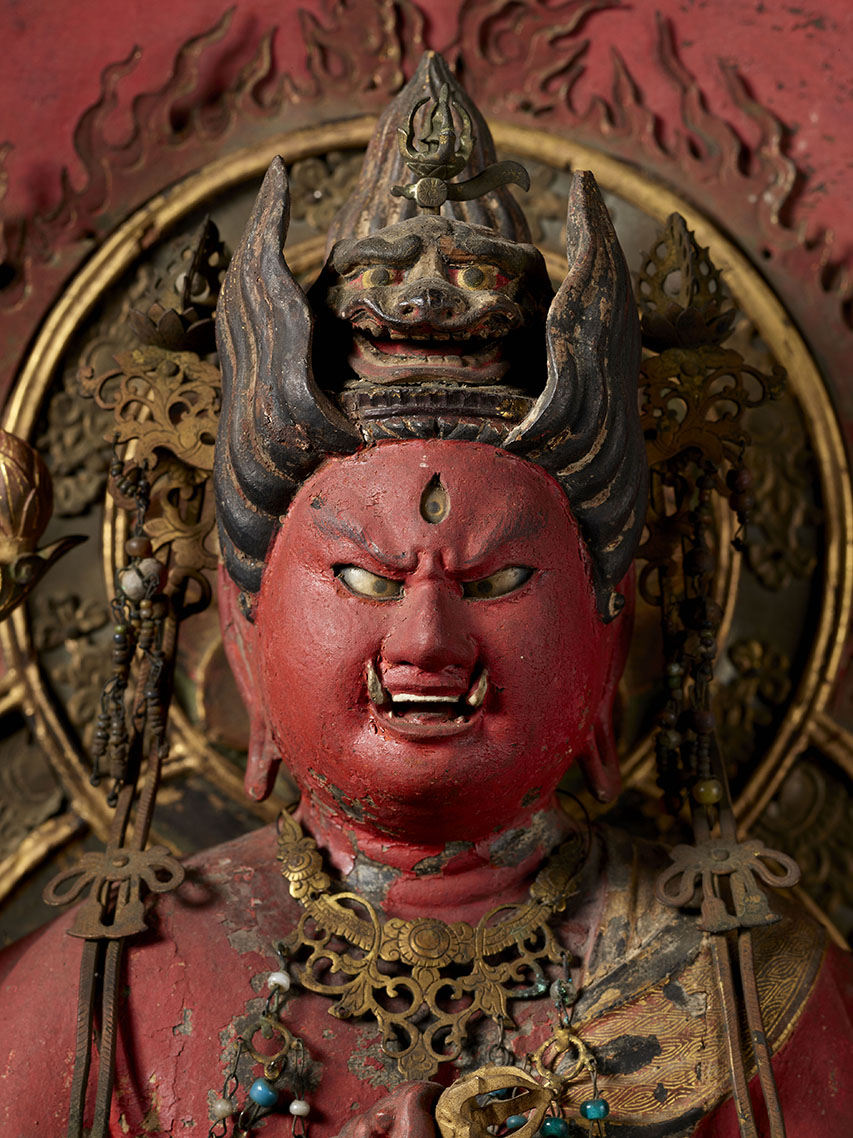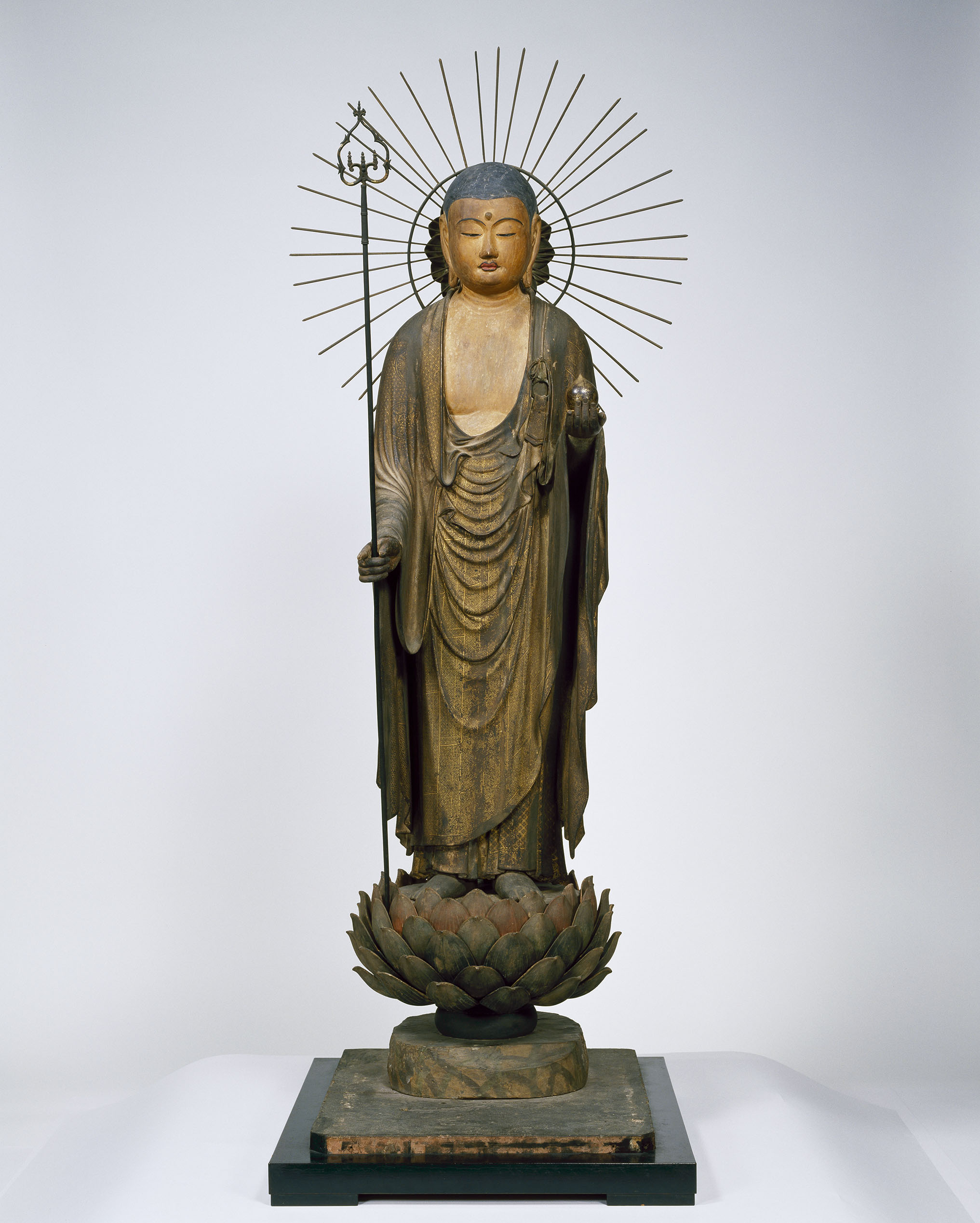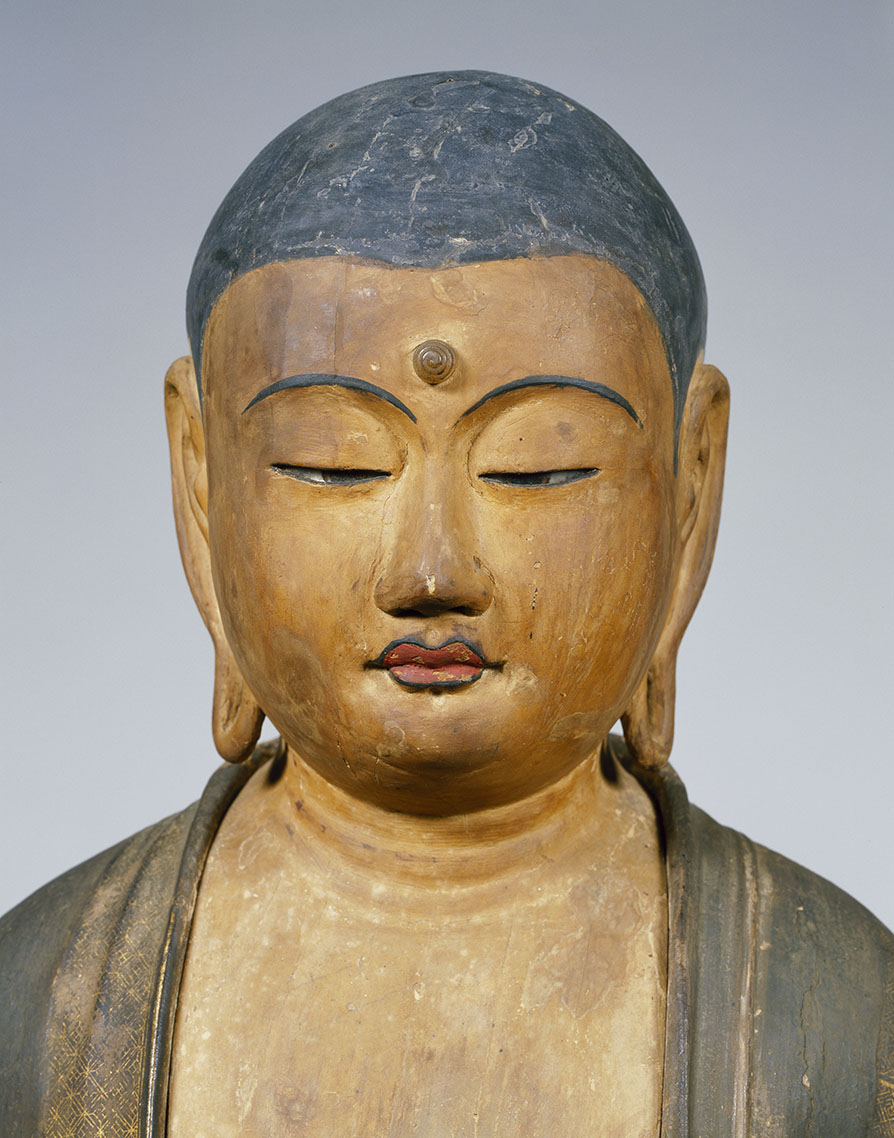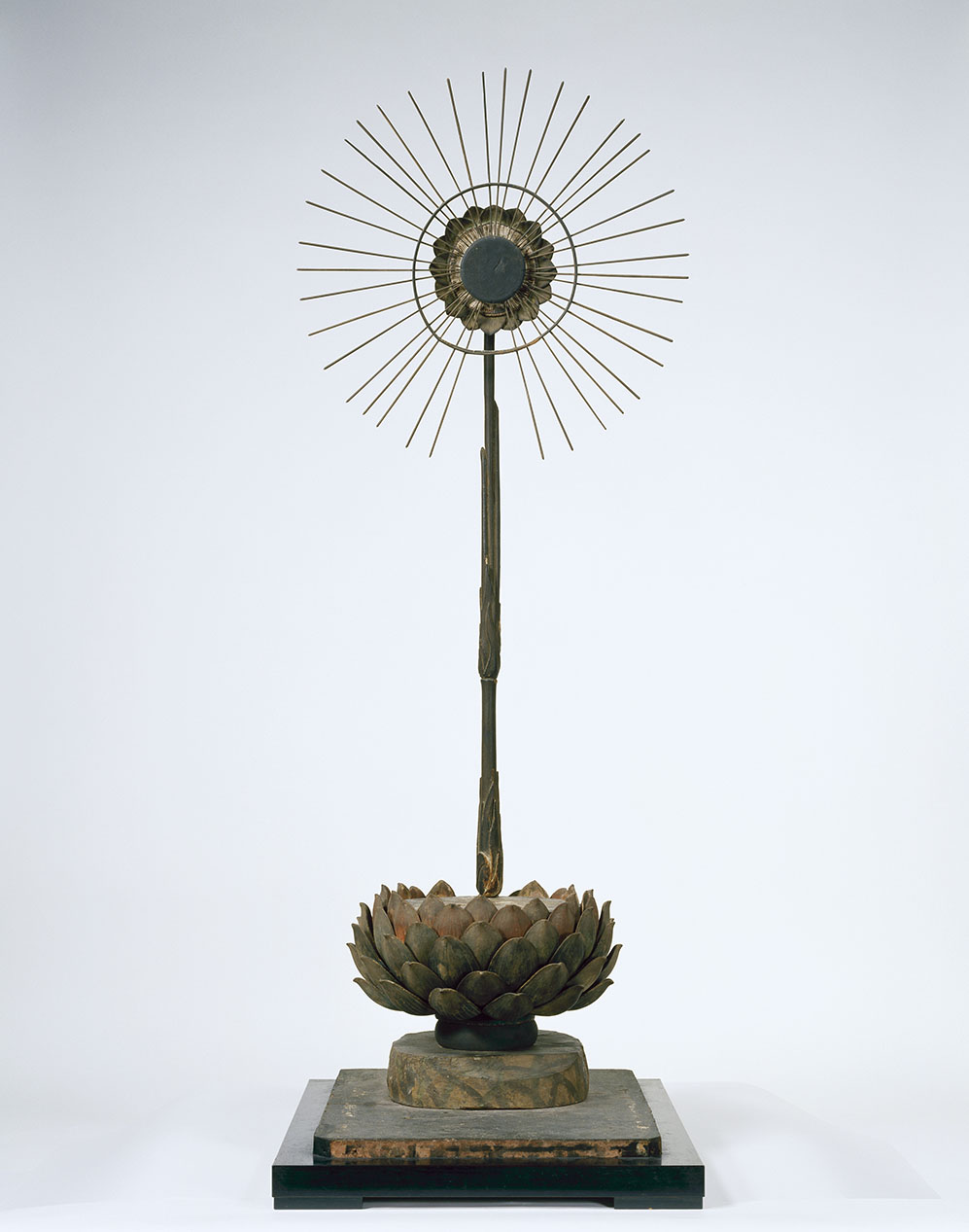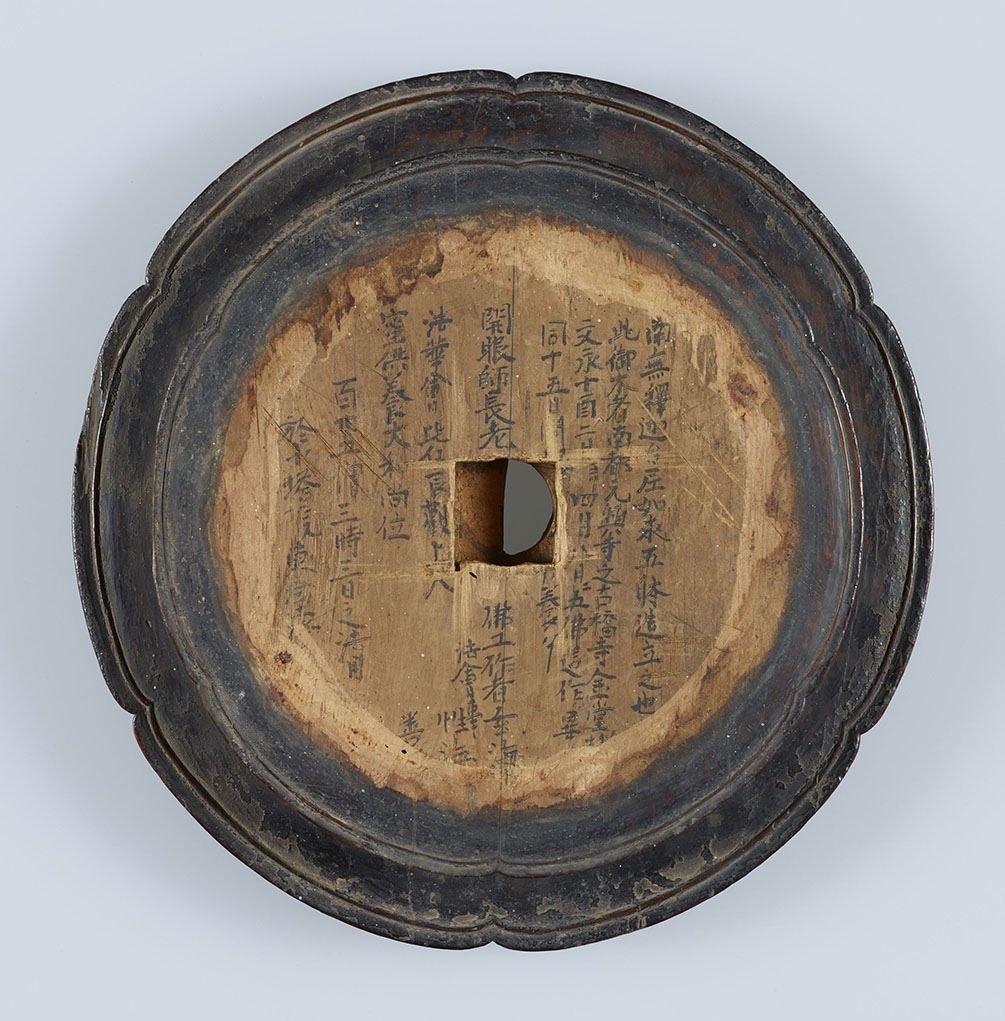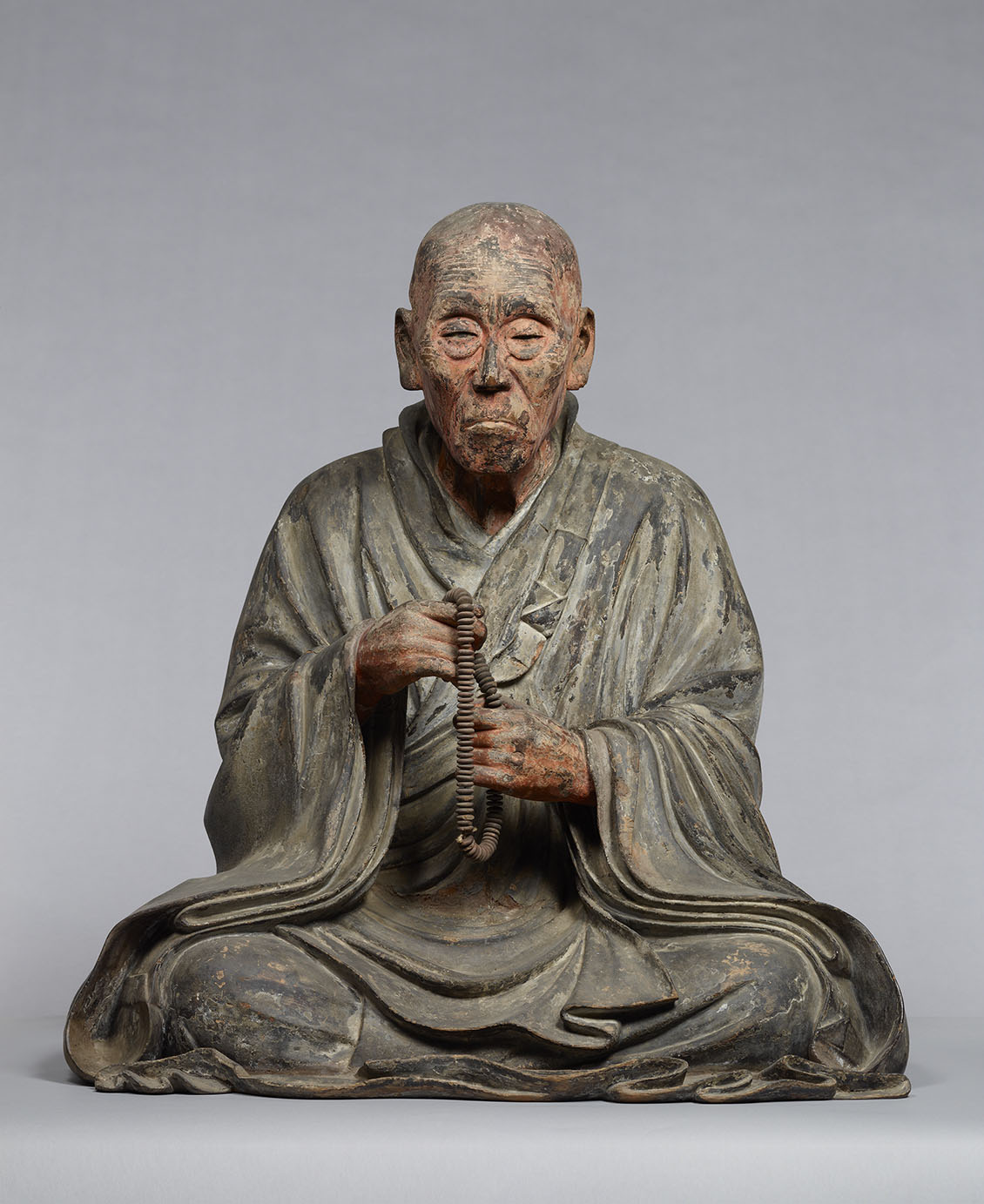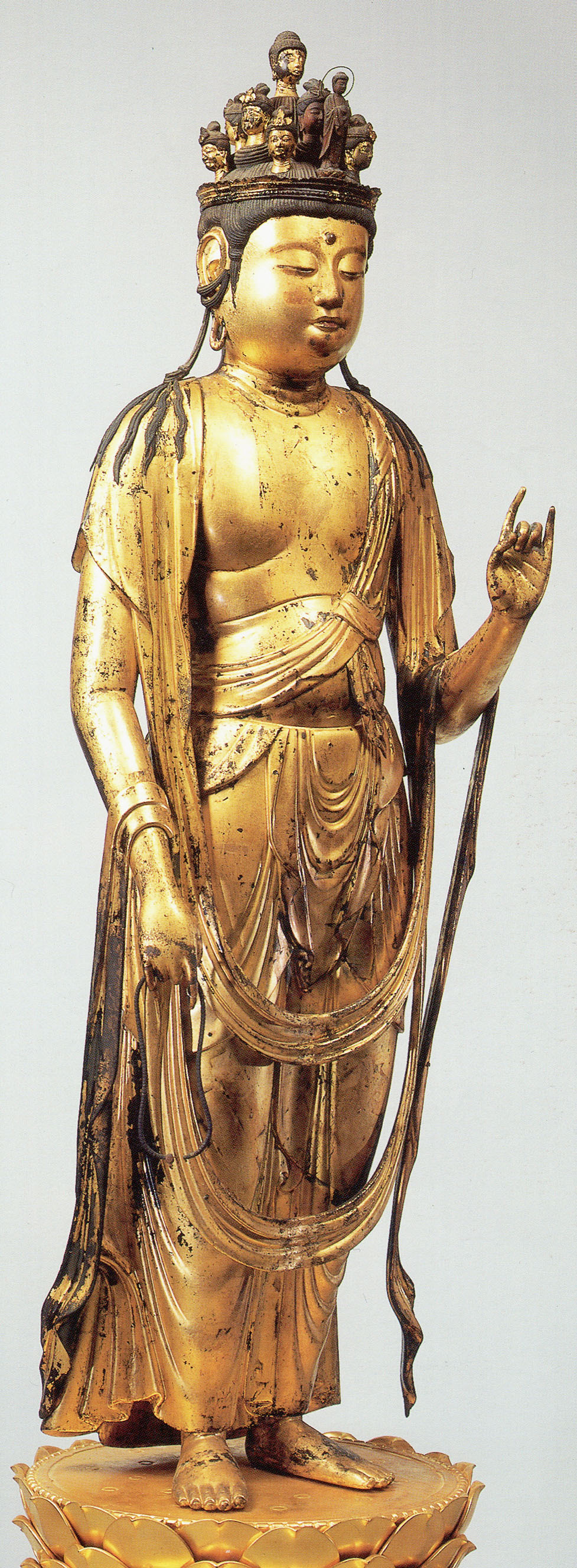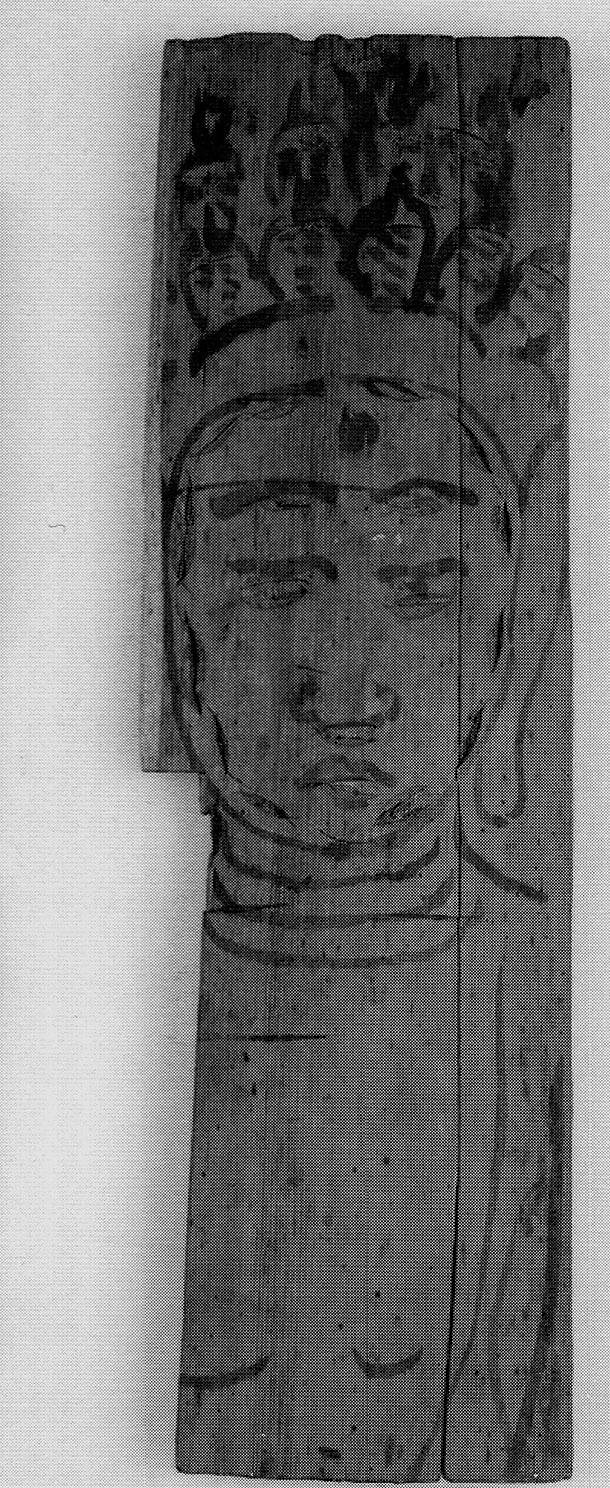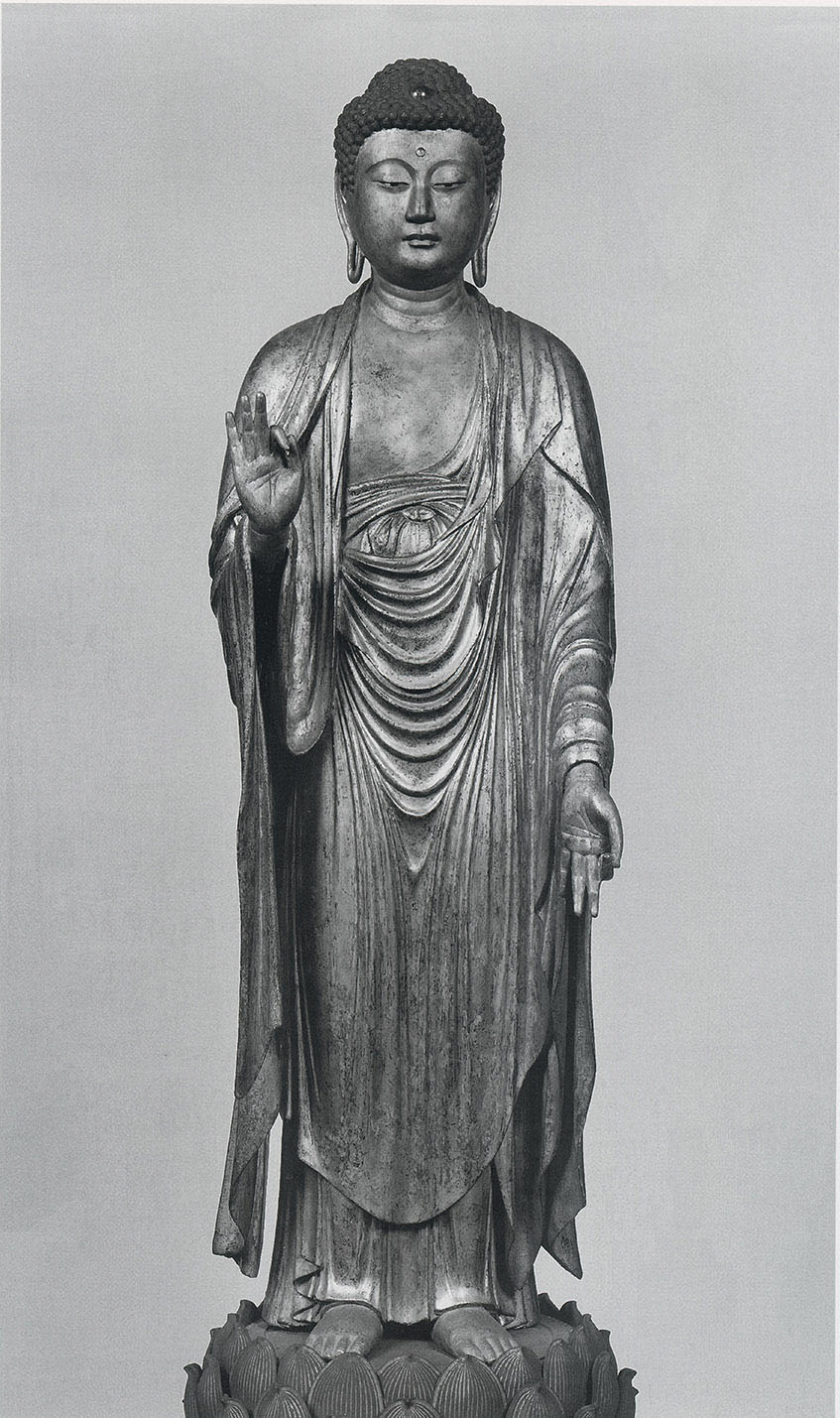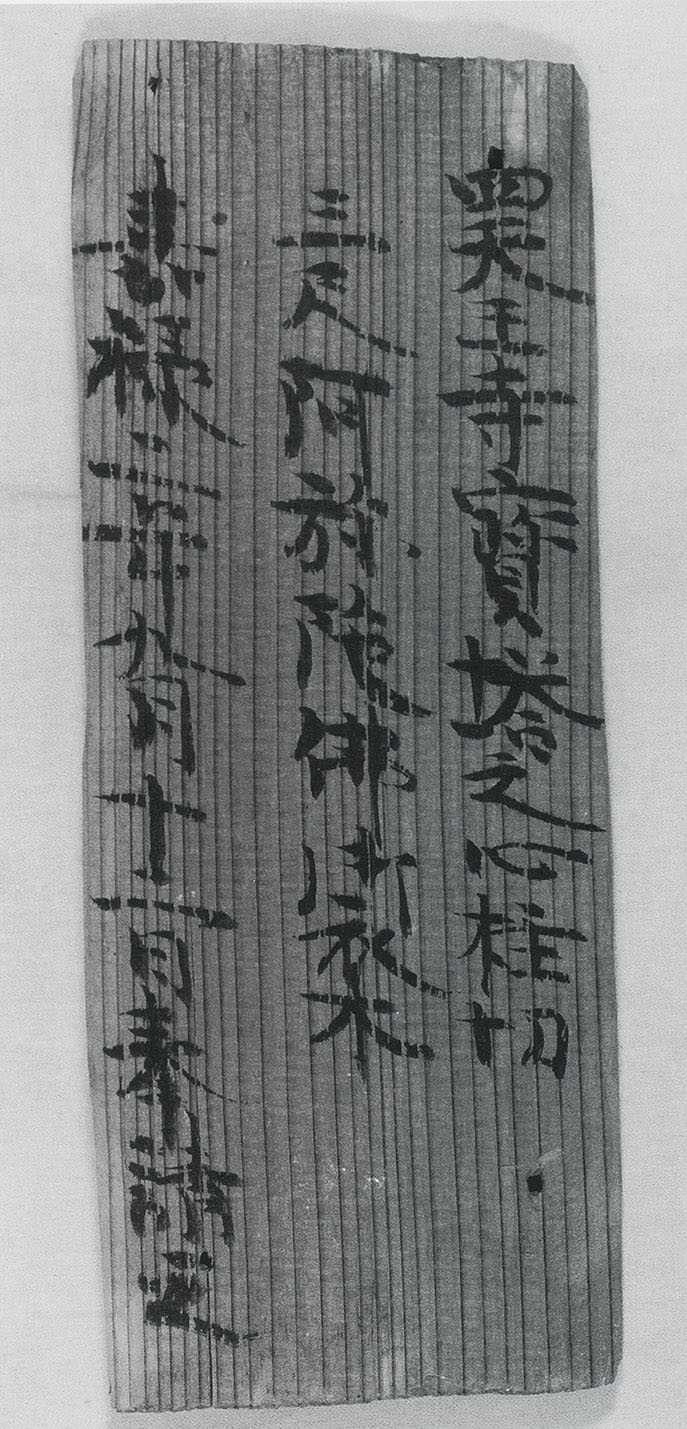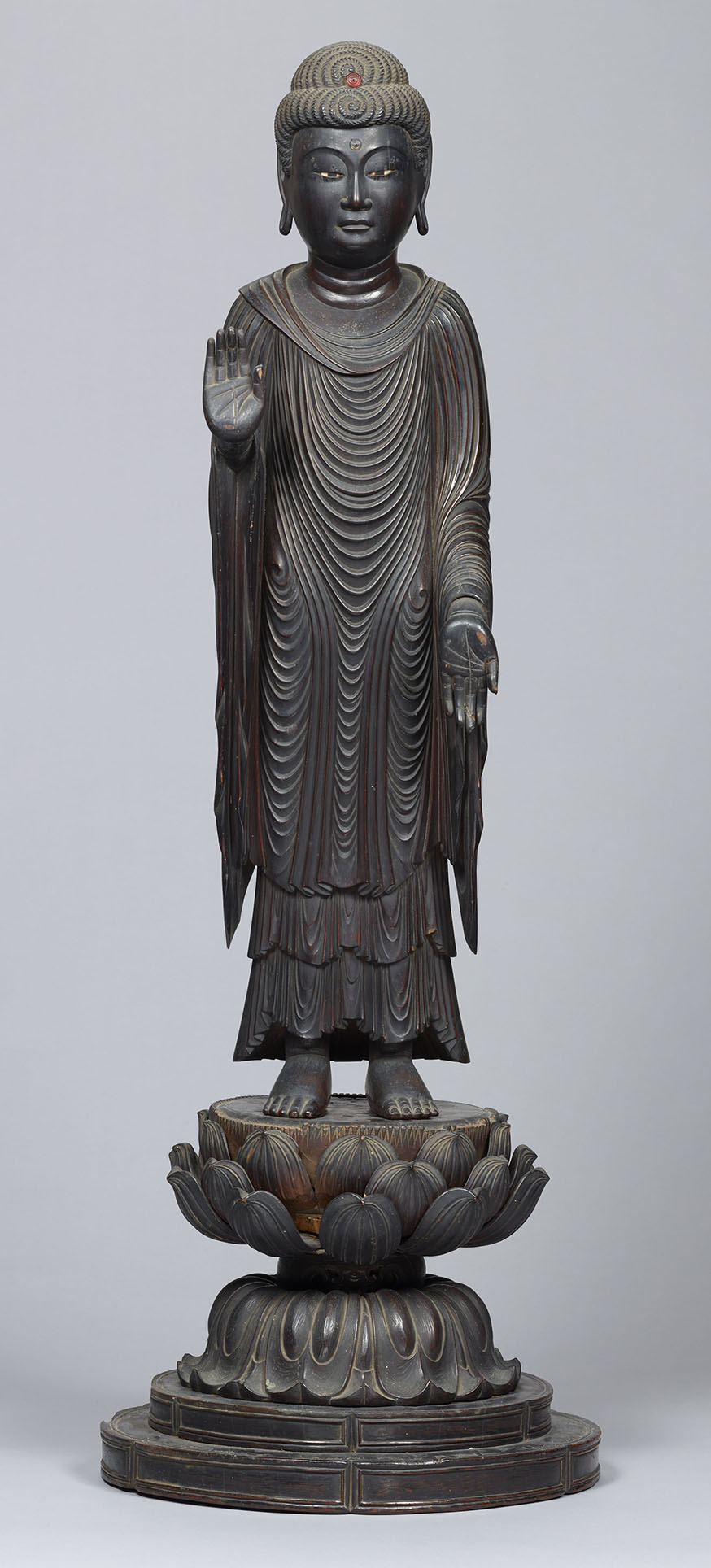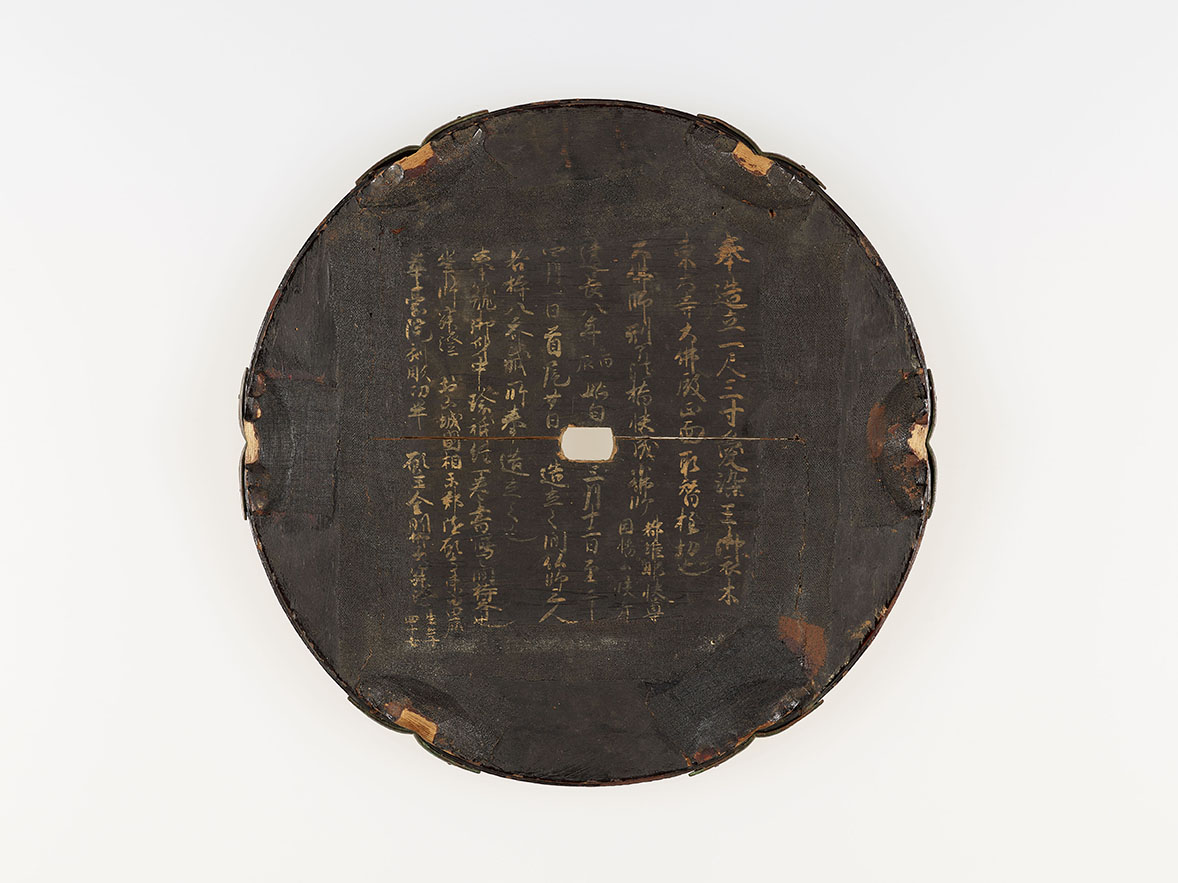Introduction
Many sculptors of the Kamakura period, in particular those trained in Nara, were devout Buddhists and often had close associations with members of the monastic community. For example, Unkei 運慶 (d. 1223), responsible for refurbishing many statues at Kōfukuji 興福寺 and Tōdaiji 東大寺 that had perished in the fires of 1180, used the title “monk” (sō 僧) by 1183, and at the end of his life had a close relationship with Myōe 明恵 (1173–1232), known for his acceptance of a range of Buddhist teachings, particularly those of the Kegon sect. Kaikei 快慶 (d. 1227), who worked closely with Unkei on the restorations, established strong ties with Shunjōbō Chōgen 俊乗房重源 (1121–1206), the monk responsible for directing the reconstruction of Tōdaiji. He shared Chōgen’s devotion to Amida (Skt. Amitābha), received the religious name An’Amidatbutsu 安阿弥陀仏from him, and after Chōgen’s death produced images for the rapidly expanding Pure Land community. Zenkei 善慶 (also known as Zen’en; 1197–1258) formed an equally close relationship with Eison 叡尊 (1201–1290), who followed Shingon teachings and also placed particular emphasis on the conferral and maintenance of the monastic precepts believed to have been established by Śākyamuni. During the latter part of his career Zenkei established an atelier on the grounds of Saidaiji (西大寺), the temple that served as the headquarters of Eison’s religious community, and produced images at the direction of the monk. Such associations existed not only between the best-known sculptors and prelates, but for other artists whose careers are known primarily through inscriptions on the statues they carved.
The close relationship that existed between these sculptors and their religious patrons meant that the artists would often maintain Buddhist precepts for the duration of the projects. Moreover, on many occasions they would participate in rituals to consecrate the wood for their statues before they began to work. While most of the timbers used for images sculpted during the Kamakura period were newly hewn, a small number were fashioned from wood that had originally been used or prepared for other purposes—temple halls and Shinto shrines. This type of creative repurposing did not occur with great frequency, but it happened often enough during the Kamakura period, as did the repurposing of other Buddhist materials, the subject of this issue, to warrant attention. As argued in this article, the meaningful repurposing of used wood had the capacity to connect past monuments, artists, and religious communities with new projects through the consistency of the original materials in their altered and reframed state, a subject also examined in Halle O’Neal’s article. While the artists who made such images are less well known than Unkei, Kaikei, and Zenkei, their works shed light on the relationship between the Buddhist sculptor and his material, and how old, historically important timbers could be refashioned to serve new purposes within religious communities substantially different from those of the buildings in which they were first used. The best-documented case of such repurposing was done by the sculptor Kaijō 快成 (b. 1226) for the monk Jakuchō 寂澄 (b. 1210).
In the third month of 1256, Master Sculptor Kaijō and two of his assistants, Kaison 快尊 (n.d.) and Kaiben 快弁 (n.d.), began work on two images, a diminutive seated Aizen 愛染明王 (figs. 1, 2), the Esoteric Wisdom King of Lust, and a standing Jizō 地蔵菩薩 (figs. 3, 4), the Bodhisattva of the Earth Matrix (Skt. Kśitigarbha). They sculpted the images at the Kedai-in 華台院, a sub-temple of a larger monastery, Zuiganji 随願寺. While the location of Zuiganji, north of Nara near the border of Kyoto and Nara Prefectures, has been identified, practically nothing else is known about the temple.1 The history of the two statues is also little known—the inscriptions on their pedestals provide the only information about them. Today, the Aizen is part of the permanent collection of the Nara National Museum, but its history is unknown prior to its purchase by the Ministry of Cultural Affairs in 1975.2 The statue of Jizō is owned by Shungakuji 春覚寺, a small temple at the western edge of Nara Prefecture, on the main route that linked the Nara basin to the sacred shrines at Ise, but it has been on loan to the Nara National Museum since 1967. According to an inscription on the pedestal, the pedestal itself, the wish-granting jewel the bodhisattva holds in its left hand, and the hands were restored in 1625, at which time the statue was kept at Jōdoji 浄土寺, a neighboring temple no longer extant.3
Face of the Aizen dated 1256 (Kenchō 8) (fig. 1)
Face of the Jizō dated 1256 (Kōgen 1) (fig. 3)
The Aizen, fashioned from a block of Japanese cypress that was split and then hollowed, conforms to the appearance of the deity as described in the “Aizen-ō” chapter in the first fascicle of the Kongō hōrōkaku issai yuga yugi-kyō 金剛峯楼閣一切瑜伽瑜祇経, the primary sutra associated with the deity.4 The body of the wrathful three-eyed, six-armed Wisdom King is colored bright red, sits cross-legged on a lotiform pedestal, and wears a lion crown. It holds a lotus, ritual implements, and weapons in five of its hands; the sixth is a closed fist. Aizen was believed to transform passions and attachments into the aspiration to attain enlightenment. In Japan the deity is most often associated with the Shingon sect and was frequently revered by monks as their personal object of devotion.
Despite the image’s small size, each element is handled with clarity and attention to the smallest detail. The full cheeks and round face give the image a youthful demeanor that tempers the ferocity projected by its knit brows, gold tusks, and focused gaze, intensified by the use of inlaid rock crystal for the eyes. The sculptors ornamented the robe with intricate cut gold-leaf patterns, which along with the polychromy remain intact. Only the five-prong vajra and the vajra-handled bell, held in two of the six hands, are later replacements.
The statue of Jizō was also crafted from a single block of Japanese cypress that was split and then hollowed. It conforms to the standard iconography of the deity across East Asia: a monk holding a staff with six rings at the top in its right hand and a wish-granting jewel in its left. This manifestation of the deity was believed to save those with sincere faith from an endless cycle of birth and rebirth in one of the many Buddhist hells, among other benefits.5
The Jizō has fared less well than the Aizen since it was carved in 1256. In addition to the repairs mentioned in the inscription of 1625, the rock-crystal eyes, most of the right sleeve, and part of the left are all replacements, and the polychromy of the flesh is also of a later vintage. In contrast, much of the original cut gold-leaf ornamentation on the monastic robes worn by the bodhisattva—undergarment, priest’s robe, and stole—is preserved. Moreover, the sculptors took great care to distinguish the interior and exterior surfaces of each garment by applying different patterns.
Similar to that of the statue of Aizen, the head is round and the cheeks are full, giving the bodhisattva a youthful appearance. The eyes are only slightly open, conveying the impression that the deity is absorbed in thought. Kaijō was certainly familiar with the naturalistic modes of figuration adopted by his predecessors in Nara, artists such as Unkei and Kaikei. This legacy is most notable in the proportions of both works and in the handling of the drapery. On the Jizō it is particularly apparent in the treatment of the robes immediately below the chest. Where the stole and the priest’s robe are tucked into the undergarment, Kaijō created a series of complex folds and pleats revealing both sides of the cloth. In addition, he varied the folds of the priest’s robe below the waist such that each traces a slightly different arc.
Little is known about the three sculptors. The inscriptions on both the Aizen and the Jizō reveal that all held honorary bureaucratic positions, a standard practice for sculptors who received official commissions; Kaijō also held the honorary rank of Bridge of the Buddhist Law (hokkyō 法橋). This was the lowest of the three titles that originally were awarded to members of the monastic community for scholarly and ecclesiastic accomplishment, but over time were conferred on people outside the religious community for artistic and other more secular achievements.6 The inscription on the statue of Jizō gives Kaijō’s age as thirty, which means he would have been born in 1226. The name Kaijō with the same honorary rank appears on two other works: a standing Amida, dated 1242, now at Mangyōji 万行寺 in Fukuoka, and one of a pair of standing Eleven-Headed Kannon 十一面観音, dated 1244, at Nakayamadera 中山寺 in Hyōgō Prefecture.7 If they were made by the same person, a view held by both Mōri Hisashi 毛利久 and Yamamoto Tsutomu 山本勉, then Kaijō would have been sixteen when he completed the Amida and eighteen when he completed the Eleven-Headed Kannon.8
The Jizō does possess some features, however, that help identify connections between Kaijō and other sculptors working in the middle decades of the thirteenth century. For example, the feet were carved individually and slid onto pieces of wood that extend from the base of the statue and are inserted into the pedestal on which the statue stands (fig. 5). The result is that they do not rest flush on the surface, and thus provide an illusion of movement. This technique was used on two statues of Jizō carved in the previous decades by Zenkei.9 The technique is also used on the statue of Amida now at Mangyōji in Fukuoka, suggesting that the Kaijō who carved that image was the same as the artist who made the Aizen and Jizō, and that he had some association with Zenkei, a connection that will be explored in greater detail below.
Feet of the Jizō dated 1256 (Kōgen 1) (fig. 3)
Also distinctive, however, was the decision by Kaijō to shape the pole supporting the mandorla as the stem of a lotus (fig. 6). Such a treatment is known on at least two other Kamakura-period works, one by Kaikei and one by his disciple Eikai 栄快 (n.d.).10 Kaijō’s adoption of an equally distinctive feature used by Kaikei and his successor for the mandola, and the use of the character kai 快 in his name, make a connection with the lineage of Kaikei also plausible.11
Mandorla of the Jizō dated 1256 (Kōgen 1) (fig. 3)
Kaijō had two other collaborators on the project. The inscription on the Jizō also relates that the statue was originally housed in a feretory with paintings in ink (either the underdrawings or the contour lines) by Kaichi 快智 (n.d.), the son of the influential early Kamakura-period painter Sonchi 尊智 (n.d.); and ones in color by Chōmyō 朝命 (n.d.), Sonchi’s disciple. Kaichi and Chōmyō were both members of the Shōnan-in painting atelier on the grounds of Kōfukuji.12 Their participation indicates that Jakuchō was able to seek out some of the painters most influential in Nara at the time for the image, and suggests that Kaijō must have been held in high regard as well.
A bit more is known about Jakuchō, who according to the inscriptions was forty-seven when the statues were carved. In both he is identified as “a disciple of the Buddha of the Vajra World” (kongō busshi 金剛仏子). This appellation was also used by Eison and indicates that both monks had received initiation in Shingon teachings. Jakuchō was clearly an important member of Eison’s community. In 1248 he received copies of important texts of monastic regulations from Eison, and in the next year he served as one of the ten patrons for the statue of Shaka carved by Zenkei in 1249, a work based upon the famous Chinese image at Seiryōji 清涼寺.13 That statue was subsequently installed as the main image of Saidaiji and became one focus of Eison’s religious practice. While no biographical information about Jakuchō is known, the relationship between the two monks must have been quite close, for his name is also included on one of the lists of the members of the religious confraternity that came together to support the portrait of Eison carved in 1280 by Zenkei’s son and successor, Zenshun 善春 (n.d.).14
Carving the Statues and the Destruction of the Great Buddha Hall at Tōdaiji
Although the inscriptions reveal nothing more about Kaijō and his two assistants, they do provide specific details about how the artists approached the production of the Aizen and the Jizō, and the material from which they were fashioned. The one on the Aizen states that during the twenty-one days it took for the sculptors to make the image they maintained the Eight Pure Precepts.15 Drawn from the monastic rules followed by monks and nuns, the precepts include sexual abstinence, avoidance of alcohol, and a prohibition on the consumption of food after noon. In the case of the Jizō, the inscription indicates that all the artists engaged in abstinence during the time it took to complete the project. As the historian of Buddhist painting Hirata Yutaka 平田寛 has observed, maintenance of the precepts by artists during the production of paintings and sculptures occurred with great frequency during the middle decades of the Kamakura period, and Kaijō and his group were no exception.16
In addition, the inscriptions relate that Kaijō did not use new timbers to make the Aizen and the Jizō, but rather repurposed wood taken from the pillars of the Great Buddha Hall at Tōdaiji. In addition, the wood of the Aizen statue is referred to as misogi 御衣木, a term that suggests the material had been specially consecrated before the sculpting began. The passages in the inscriptions that make reference to the source of wood from which the images were fashioned read as follows: “[a piece] cut from a replaced pillar from the façade of the Daibutsu-den 大仏殿 at Tōdaiji,” in the case of the Aizen (fig. 7); and “used all of [a piece] cut from a replaced pillar from the west façade of the Daibutsu-den,” for the Jizō (fig. 8).17 Neither passage specifically indicates if the pillar was one prepared for the reconstruction of the Great Buddha Hall, completed in 1203, or if it was taken from the remains of one of the pillars fashioned from the great trunks of Japanese cypress from the eighth-century structure that burned in 1180. However, it is most likely Kaijō used wood from the pillars of the lost original.
Inscription on the Aizen dated 1256 (Kenchō 8) (fig. 1)
Inscription on the Jizō dated 1256 (Kenchō 8) (fig. 3)
The destruction of the Great Buddha Hall at Tōdaiji and its monumental gilt-bronze statue of the Cosmic Buddha, Vairocana (J. Birushana 毘盧遮那) in the twelfth month of 1180 was one of the most traumatic events in early Japanese history. The compound burned when forces led by Taira no Shigehira 平の重衡 (1156–1185) accidentally set fires as they entered Nara to punish the monks of Kōfukuji, who supported their opponents in the extended conflicts for political control of the country that had begun some twenty years earlier. The Tale of Heike, a later account of the conflict, graphically describes the destruction of Tōdaiji, long considered the symbol of the country’s enduring support of the Buddhist faith:
The reaction at the time was equally intense. The influential courtier Kujō Kanezane 九条兼実 (1149–1207), head of the Fujiwara clan at the time, observed:But now the head of the holy image (Great Buddha)—that face resplendent as a full moon melted and fell to earth, and the body fused into a mountainous heap. Smoke permeated the heavens; flames filled the air below. Those present who witnessed the sight averted their eyes; those afar who heard the story trembled with fear. Of the Hossō and Sanron scriptures and sacred teachings, not a scroll survived. It was impossible to imagine such a devastating blow to the Buddhist faith in India or China, to say nothing of our country.18
For Kujō Kanezane and many others, the destruction of the temple and its image further confirmed that the country was in the period of the End of the Buddhist Law (mappō 末法), characterize by chaos and religious decline.The law of the Buddha and the law of the ruler, instituted for the sake of humanity, have been utterly destroyed. Neither spoken nor written words can describe it. When I heard [of the destruction] my spirit was demolished.19
Measures were immediately taken by the court to restore the image and rebuild the structure that housed it. By the sixth month of 1181 the courtier Fujiwara no Yukitaka 藤原の行隆 (1130–1187) was appointed to the position of Chief Official for Construction of Tōdaiji, and in the eighth month Chōgen was designated solicitor, in charge of raising funds for the project. The casting of the new image was completed in 1185 but was not dedicated until the hall to house it was finished in 1195.
While it is only possible to speculate, it is hard to imagine that Jakuchō and Kaijō would have provided such specificity of location in the inscriptions for leftover blocks of wood from the timbers used for the new structure. While the Great Buddha Hall rebuilt by Chōgen was most certainly an impressive architectural achievement, its timbers would not have been considered to possess the historical and religious associations of those of the original, commissioned by Emperor Shōmu 聖武天皇 (701–756; r. 724–749) in the mid-eighth century to express imperial support for the Buddhist faith. Moreover, such a choice was not without precedent.
Two other examples shed light on the reuse of wood from the Great Buddha Hall for Buddhist images by Kaijō and Jakuchō. The best-known instance of a Buddhist sculptor repurposing wood was initiated by Unkei; however, it did not involve making a sculpture, but rather two copies of the eight-scroll set of the Lotus Sutra in 1183. As the person who organized the project, Unkei is listed as “Chief Patron, Monk Unkei” 願主僧運慶 implying that by that time he had taken lay-Buddhist vows. He was joined in commissioning the project by “Chief Female Patron” (onna daiseshu 女大施主), most likely his wife, and a child named Akomaro 阿古丸, probably his eldest son, Tankei 湛慶 (1173–1256).20
The inscription at the end of the eighth scroll as well as inscriptions on the rollers of all the scrolls in the set reveal the devastating impact of the destruction of Tōdaiji on Unkei and his fellow sculptors.21 The passage is one of the most compelling personal documents describing devotional activities by a sculptor in Japan. From it we learn that Unkei had originally intended to undertake the transcription between 1175 and 1177, but was unable to do so. When he returned to the project in more precarious times and with the Great Buddha Hall lying in ruins, Unkei, his wife, and Akomaro abstained from eating meat and fish, and donned monastic robes prior to preparing the paper for the scrolls themselves. They began that process on the eighth day of the fourth month, the anniversary of the birth of the Historical Buddha, finishing on the twenty-eighth. The next day the copying of two sets of the text began, one by the monk Chinga 珍賀 (n.d.) that remains today and one by the monk Ei’in 栄印 (n.d.) that is now lost.
For the rollers for the scrolls, Unkei used pieces of wood salvaged from the charred timbers of Tōdaiji, a testament to the deep emotional bond he felt with the Nara temple. Each bears an inscription stating that “the wood for the rollers were remnants from a burned pillar at Tōdaiji.”22 It goes on to state that the Great Deity of Kasuga 春日大明神 had appeared in a dream to direct him to use the wood. In the inscription on each of the rollers (as well as in the dedicatory text), the wood is further described as “the most sacred wood among sacred wood,” clear indication of the reverence afforded the Great Buddha Hall among the religious and artistic community in Nara.23
More than fifty people, monks and laity, aristocrats and commoners, men and women, joined the main religious confraternity that sponsored the transcription. Among them were Kaikei, who would subsequently become deeply involved with the reconstruction of Tōdaiji, and other sculptors who subsequently joined Unkei on his projects. The participants performed triple prostrations and recited the “Treasure Name” (hōgō 宝号) of the Lotus Sutra, and invoked the name of Amida, Lord of the Western Paradise (nenbutsu 念仏), after each line was copied. By the time the two sets of eight rolls were completed and dedicated they had prostrated themselves fifty thousand times, chanted the nenbutsu one hundred thousand times, and recited the Treasure Name one hundred thousand times. While the location of the event is not specified, it likely occurred in Nara, where Unkei and his fellow sculptors resided, with the remains of the Great Buddha and the hall that once housed it nearby.
There are no records of Unkei using wood from the destroyed Great Buddha Hall for a Buddhist image. However, the deeply moving portrait of Shunjōbō Chōgen (fig. 9) carved at the time of his death is universally acknowledged to be by the hand of a Kei school artist, and the sculpture historian Soejima Hiromichi 副島弘道 believes strongly that it was made by Unkei.24 The image was fashioned out of ten pieces of wood using the joined woodblock technique. When the statue was examined in the 1960s, it was discovered that the underside of the block forming the left shoulder was charred.25 Given Chōgen’s connection with Tōdaiji, and the context of the statue as a memorial portrait, it seems likely that this block, and possibly all the wood to make the image, was taken from the remains of timbers from the destroyed Great Buddha Hall.
By using the “the most sacred wood among sacred wood” for the sutra rollers, and most probably for at least part of the statue of Chōgen, Unkei was associating both objects with physical material from Shōmu’s creation and ensuring that at least a part of the structure and its historic and religious associations would be passed on to future generations. While Kaijō’s statues were separated from Unkei’s projects by many decades, by using wood remaining from the first Great Buddha Hall, he too embedded the Aizen and the Jizō into a web of religious and historical relationships that went beyond their outer appearance.
Misogi-Consecrated Wood for Buddhist Sculptures
Unkei’s deep commitment to the Buddhist faith is attested not only by the sutra-copying project of 1183, but by the reverence with which he approached the making of images as well. One example is the group of the statues in the North Octagonal Hall of Kōfukuji completed in 1212: the Buddha Miroku 弥勒仏 flanked by images of the Hossō 法相 patriarchs, Asanga (無着 Muchaku), Vasubandhu (世親 Seshin), and the Four Divine Kings. Before Unkei, his two assistants, and his six sons began work on the images, they all donned specially prepared robes for a misogi ritual that was held in the courtyard in front of the hall.26 The etymology of the term, consisting of the enigmatic grouping of characters for garment and wood preceded by one used as an honorific, is obscure; however, it seems likely that it is derived from a homophone with a different character that means “to purify with water.”27 During the Heian and Kamakura periods, misogi was used to refer to wood that would be or had been consecrated before being fashioned into Buddhist images.
Trees had long been considered sacred in the indigenous religious tradition in Japan. As explained by Fabio Rambelli, fashioning them into Buddhist images required ritual and liturgical slights of hand, and he suggests that “the subjugation of local deities by buddhas and bodhisattas was actively and ritually displayed through the felling of trees taken to be ‘sacred.’”28 Perhaps the best-known account of a tree being tamed by transforming it into a Buddhist image is the legend associated with the Eleven-Headed Kannon at Hasedera 長谷寺. Prior to being fashioned into the image, the giant log caused illness and death.29 The misogi ritual can thus be understood as part of the process described by Rambelli, since it transformed ordinary timbers into a sanctified material appropriate for sculpting into Buddhist statues.
One of the earliest identified uses of the term misogi for wood to be made into Buddhist statues appears in the Gonki 権記, the diary of Fujiwara no Yukinari 藤原の行成 (972–1027), courtier, calligrapher, and close confidant of Fujiwara no Michinaga 藤原の道長 (966–1028). He describes an occasion in 999 when he traveled with Acting Priest General Kanshū 権僧正勧修 (945–1008) to the residence of the sculptor Kōjō 康尚 (n.d.), father of Jōchō 定朝 (d. 1057), the artist of the Amida at the Byōdo-in 平等院. Kōjō was preparing to carve statues of the Buddha Dainichi 大日如来 and the bodhisattvas Fugen 普賢菩薩 and Eleven-Headed Kannon, for his private temple in Kyoto, Sesonji 世尊寺. Yukinari writes:
Yukinari does not specify how Kōjō revealed the images on the misogi, but clearly they met the expectations of the Priest General. Based on examples from later in the Heian period, he most likely drew their form on the logs that would subsequently be fully revealed by his adze and chisel.31Kōjō first cut the misogi. He [then] revealed the deities and stood the [timbers up]. The Priest General then reverentially stated the essence of the prayers, and added, “There is no deviation from the thought I had in my mind.” Then his disciples took up axes and after they carved the misogi of the three deities, everyone made obeisance.30
Other references to misogi from the eleventh and early twelfth centuries are relatively few in number. They most often are in regard to wood prior to its being made into images. One mentions the payment provided for misogi for statues for Hosshōji 法勝寺, the grand temple built by Emperor Shirakawa 白川天皇 (1053–1129; r. 1073–1087) on the eastern side of Kyoto.32 Another describes the harvesting of trees on an auspicious day to be used as misogi for statues for a pagoda at Kasuga Shrine 春日大社.33 A third refers to going into the mountains to harvest misogi for the wood that was carved into the seated Amida now housed at Zenmyōji 善明寺 in Shiga Prefecture.34
The term appears with greater frequency in texts and inscriptions from the end of the Heian period and throughout the Kamakura period, and some describe in detail the ritual that transformed ordinary logs into sacred wood. A representative example can be found in the Sankaiki 山槐記, the diary of the courtier Nakayama no Tadachika 中山の忠親 (1131–1195).35 In the tenth month of 1178, the logs for a set of Six Kannon were consecrated at the palace of the retired empress. Myōen 明円 (d. 1199), the head of the En school and the most influential sculptor in the capital at the time, was in charge of the project. Dressed in sanctified garments and a purple monk’s robe (kesa 袈裟), Myōen, assisted by five disciples, first laid out the logs on straw mats in the south veranda. The sculptors were then joined by the eminent Shingon prelate Kakujō 覚成 (1126–1198), who presided over the ritual. Once concluded, Myōen drew images of the deities on the logs and then took up an axe and lowered it three times on each of them. He then performed some carving on the now-consecrated log that would become the Eleven-Headed Kannon, and his five assistants did the same for the other images. When they were finished, all departed and the misogi were set up on the east altar of the Jōkō-in 常光院, a chapel within the palace.
Tadachika’s description of the ritual of 1178 that transformed sawed timbers into numinous pieces of wood suitable for Buddhist images follows the oldest recorded version of the misogi liturgy, the Order of Service for Misogi Rituals (On Misogi kaji sahō 御衣木加持作法), dating to the thirteenth century.36 Clearly by this time the misogi ritual was held with enough frequency to warrant some attempt at standardization. The liturgy and added commentary include numerous details. These are the most salient features.
Three days before the ritual takes place, the sculptor is obliged to abstain from eating meat and fish. If the sculptor is a layperson, then he must receive the Eight Pure Precepts. If the sculptor has already taken religious vows, then he should be asked if he has received the Ten Major Precepts of the Bonmō-kyō 梵網経, the most important of the Mahayana precepts, and if he has not, he must receive them.37 In either case, while making the image, the sculptor must not violate these prescriptions.
Once the logs are harvested, they must be delivered to the site of the ritual at the hour of the tiger (3:00–5:00 a.m.), at which time they should be purified with sacred water. After the ritual space is prepared, the logs are lined up. Then the sculptor washes them with perfumed water, removes the bark, and places them on a specially constructed altar.
The service is conducted by a Ritual Master (jushi 呪師). Once it begins the sculptor sprinkles the wood, carving tools, and ax with sake to purify them. Following chanting of the mantra of the deity to be fashioned from the timbers, the sculptor writes the Sanskrit seed character on one near the location of what will become the statue’s chest. After a sequence of invocations, offerings, and chants, the sculptor first ceremonially lowers his ax on a timber and begins carving. When finished the sculptor then takes the consecrated wood and departs. The ritual master offers more prayers and incantations, and then the ritual concludes.
According to the commentary, if the image is to be made in a single day, then the ritual master intones chants and burns incense without stopping until the sculptor is done. If the carving is to take many days, then these actions take place before the sculptor begins, and offerings are made after he finishes. The misogi is just the first in a series of practices to sanctify an image and keep it ritually efficacious. A number of these, including consecration and rededication, are described in detail in Benedetta Lomi’s article in this issue.
The descriptions in the Gonki and the Sankaiki generally follow the sequence described in the text of the Order of Service for Misogi Rituals, the main difference being that both Kōjō and Myōen drew images of the deities on the logs, rather than only writing the seed characters. Drawing on the timbers must have been common practice. For example, in the depiction of the ritual in the second scroll of a Muromachi-period version of the Hasedera engi emaki 長谷寺縁起絵巻, the illustrated version of the Hasedera legend, the presiding monk is depicted having just finished sketching an image of the deity on two logs.38
Confirmation that this procedure was at times closely followed is provided by a board with an image of the head and chest of the deity simply sketched in ink found inside the late twelfth-century statue of the Eleven-Headed Kannon at Seikōji 誓光寺 in Kōka City, Shiga Prefecture (figs. 10, 11).39 Careful observation reveals a series of curved chisel marks along the brushstrokes delineating the contours of the face, the facial features, and the additional heads in the crown, as well as three horizonal cuts on the neck and chest. The anonymous sculptor made the image manifest through a brush. The ceremonial lowering of an ax and symbolic carving of the image together sanctified the wood. This piece of wood with its drawing also implies that for other than the smallest images, it is likely that one piece of wood was used to represent the entire image in the ritual.
Plaque with drawing of Eleven-Headed Kannon found inside the Eleven-Headed Kannon at Seikōji (fig. 10)
For statues to be fashioned from new wood, such as the Eleven-Headed Kannon at Seikōji, the wood had to be consecrated before the carving could begin. Both the Order of Service for Misogi Rituals and many of the textual references to the term from the Heian and Kamakura periods, including the ones cited above, stress the importance of harvesting new wood, often from sacred locations, for statues.40 In the case of the two statues carved by Kaijō, the wood was different in a fundamental way since it had been recycled from the Great Buddha Hall. Nevertheless, the inscription on the Aizen refers to the wood as misogi.41 Whether Kaijō and Jakuchō held a misogi ritual is unknown, although Washizuka Hiromitsu 鷲塚泰光 believes they did so.42 In either event, the sculptor and his patron would likely have considered the material sacred and powerful because of its previous status as part of the most influential temple to have been built in Japan. The three sculptors did follow at least one of the prescriptions of the misogi ritual—maintaining the Eight Pure Precepts during the twenty-one days it took to carve the Aizen and Jizō. This practice gained in importance in the middle decades of the Kamakura period, as artists increasingly worked directly for monastic patrons at temples, and became active participants in the religious movements that grew up around them. It was especially true for sculptors like Kōjō who were working for members of Eison’s community.
Repurposing Architectural Timbers
Three other occasions of sculptors refashioning architectural timbers into Buddhist images are known from the Heian and Kamakura periods, and in two of those cases the wood is referred to as misogi. In 1250 the courtier and former regent Kujō Michiie 九条道家 (1193–1252) wrote a document for his grandson describing his assets and the religious institutions he had supported.43 In it Michiie describes the halls and images at Kōmyōbuji 光明峰寺, a temple he had established in southeast Kyoto. Michiie notes that the life-size seated statue of Dainichi, the Esoteric manifestation of the Cosmic Buddha housed in the Main Hall, was carved by Kōkei 康慶 (n.d.), the first sculptor of the Kei school and father of Unkei, and was fashioned out of misogi from the shin no mihashira 心の御柱 (heart pillar) of the shrine at Ise 伊勢神宮. Asaki Shūhei 麻木脩平 has convincingly suggested that the Dainichi and four other images by Kōkei were commissioned by Michiie’s grandfather Kujō Kanezane, who had close relations with the Nara sculptors through his involvement with the reconstruction of Kōfukuji and Tōdaiji. Asaki believes the five sculptures were carved before 1196 and moved to Kōmyōbuji from Hosshōji when much of the compound of that temple was appropriated for the construction of Tōfukuji 東福寺.44
The historian of Shinto Murei Hitoshi 牟禮仁 subsequently suggested that the shin no mihashira used to make the Dainichi was the one put in place in 1171 for the twenty-year ritual reconstruction of the Inner Shrine, dedicated to Amaterasu 天照大神, the Sun Goddess and imperial ancestress. It would have been removed and replaced in 1189 for the reconstruction in 1190.45 At the Inner Shrine, the heart pillar is fully buried in the ground under the Shōden 正殿, and is considered to be particularly sacred.46 Nothing else is known about the now-lost image at Kōmyōbuji. However, since Dainichi was believed to be the honji 本地, or “original ground,” for which Amaterasu was the suijaku 垂迹, or “trace manifestation,” the reuse of what might be considered the most sacred wood in the indigenous religious tradition for a statue of Dainichi has a theological precedent.
The Dainichi at Kōmyōbuji is not the only lost image said to have been made from one of the shin no mihashira of Ise Shrine. An entry for 1195 in the Azuma kagami 吾妻鏡, the chronicle of the Kamakura shogunate, records that Minamoto no Yoritomo (1147–1199) made a donation of fields to the Dainichi-dō 大日堂 on the Ōba estate 大庭御厨 in the province of Sagami, west of Kamakura, to provide funds for the sacred lamps of the Buddha.47 It also mentions that the image in the hall had been commissioned by Kamakura (Taira) Kagemasa 鎌倉 (平) 景政 (b. 1069) and was made from the shin no mihashira of Ise Shrine when it was replaced on the twenty-year cycle. Murei has studied this record in detail as well, and while he has doubts about the reliability of the account of the creation of the statue, he has no such doubts about Yoritomo’s donation and belief in the legend associated with the image.48 Murei further observes that Yoritomo made the donation to the Dainichi-dō after returning from the rededication of the Great Buddha that took place in the third month of 1195. He thus surmises that the extraordinary use of the shin no mihashira for the statue of Dainichi commissioned by Kujō Kanezane and Yoritomo’s donation to the Dainichi-dō may have been motivated by the reconstruction of the Great Buddha.49
The earliest extant image that can be confirmed to have been made from repurposed wood is a standing Amida 阿弥陀如来 (fig. 12) fashioned by an anonymous artist that was brought to Edo in the late sixteenth century and today is the main image of Higashi Honganji 東本願寺 in Taitō Ward in Tokyo.50 When the statue was disassembled for repairs, a piece of wood was discovered inside with an inscription stating that “the misogi for the three-foot (sanshaku 三尺) Amida was [a piece] cut from the central pillar of the Jewel Pagoda (hōtō 宝塔) at Shitennōji (四天王寺),” and with a date of 1226 (fig. 13). The five-story pagoda at Shitennōji burned in 960 and was not rebuilt until the eleventh century. That structure was subsequently repaired in 1201.51 As is the case with the statues of Aizen and Jizō by Kaijō, the inscription does not make clear if the wood for this image was taken from the old central pillar or from wood that was used in its repair. However, since the sculptor or patron took the effort to mention the source in the dedicatory inscription, it seems likely that wood from the earlier pagoda, sacralized by its incorporation into a structure that housed relics of the Historical Buddha, was set aside to be used in a commission twenty-five years later.
Piece of wood with inscription found inside the Amida at Higashi Honganji (fig. 12)
While nothing of the history of this statue prior to the sixteenth century is known, the choice of wood from the central pillar of the five-story pagoda at Shitennōji for the statue most certainly endowed the Amida with added authority. The temple had been founded in the sixth century by Prince Shōtoku 聖徳太子 (574–622), who over time came to be viewed not only as the founder of Buddhism in Japan, but as the country’s own Śākyamuni. The “Handprint Origin Tale” (Go-shuin engi 御手印縁起) discovered there in 1007 asserts that the temple was the very place where Śākyamuni preached.52 By the twelfth century, Pure Land beliefs had fully infiltrated the sanctuary as well, and the torii outside the West Gate was believed to be the eastern entrance to Amida’s Pure Land. By the time the pagoda was rebuilt in the thirteenth century, the temple had become a pilgrimage site for aristocrats, monks, and commoners alike who all wanted to express their devotion to the legacy of the prince. Thus, carving a statue of Amida from wood from the temple’s pagoda most likely drew upon the authority of both the Historical Buddha and Prince Shōtoku, while also asserting Shitennōji’s place in the rapidly developing Pure Land orders.
The fourth instance of an image fashioned from wood taken from a temple building is a statue of Shaka 釈迦如来 in the style of the image at Seiryōji (figs. 14, 15) dedicated in the fourth month of 1273.53 The timing of the sculpting would have been considered to have been particularly propitious—the project was begun on the anniversary of the death of the Historical Buddha (the fifteenth day of the second month), and finished on the anniversary of his birth (the eighth day of the fourth month). According to the inscription, the statue was originally part of a group of five similar images, fashioned by the sculptor Genkai 玄海 (n.d.) from old pieces of wood from the Main Hall of a temple named Kokyōji 古橋寺 associated with Gangōji 元興寺 in Nara; however, nothing more is known of the artist or the temple (fig. 16).54 The image was carved from a solid block of Japanese nutmeg-yew (kaya 榧; Torreya nucifera). Only the head was hollowed, and X-ray photographs have revealed a reliquary suspended in the cavity.55
Face of the Shaka dated 1273 (Bun’ei 10) (fig. 14)
Inscription of the Shaka dated 1273 (Bun’ei 10) (fig. 14)
Ninshō 忍性 (1217–1303), Eison’s most important disciple, who is referred to in the inscription by his alternate name, Ryōkan 良観, dedicated the image. He was joined in officiating at the event by Shōkai 性海 (1235–1292/98), another influential member of Eison’s community, and 125 monks are recorded as having been in attendance. The dedication was held at the East Residence (Higashi muro 東室) of the Shōtō-in 小塔院, a compound of Gangōji that had been established in the second half of the eighth century.56
The Seiryōji statue, brought from China in 986, was believed to be a representation of the first image of the Historical Buddha fashioned out of sandalwood during his lifetime. The first copies of that renowned statue were made in the Heian period, but the practice became particularly popular at temples affiliated with Eison’s religious community after 1249, when Zenkei carved the statue installed as the main object of worship at Saidaiji. In fact, Ninshō was directly involved with the creation of one such replication at Gokurakuji 極楽寺 near Kamakura at about the same time as this image was carved.57 For Eison, Ninshō, and their followers, who put particular emphasis on the conferral and maintenance of the precepts, the original and its replications represented the source of the fundamental tenets of their beliefs.
The Shaka statue of 1273 mirrors the original in the overall arrangement of the robes, the distinctive spiral pattern of the hair, and the conspicuous incised lines on the hands. Yet it clearly reveals its late thirteenth-century date in its youthful, more naturalistically proportioned face, and the use of the inlaid rock-crystal eyes. The decision to use Japanese nutmeg-yew for the image and its pedestal clearly reflects an attempt to create a material association with the statue at Seiryōji, for Japanese nutmeg-yew was frequently used as an alternative to sandalwood during the eighth and ninth centuries.58 However, the wood was rarely used for architectural projects throughout Japanese history.59 Why Japanese nutmeg-yew would have been used in the construction of the otherwise unknown Kokyōji is unclear, and to make five sculptures and pedestals of the same size would have required Genkai to reuse multiple pillars or large rainbow beams. Nevertheless, by fashioning the image and its lost companions with material associated with a temple with connections to Gangōji, an important center of Buddhist scholarship and the successor in Nara to the first temple established in Japan, and most likely dedicating them on the grounds of the temple, the statues would have been provided with added legitimacy drawn from the past. Of equal importance may have been the fact that the main object of devotion of the first Gangōji was an image of Shaka, commissioned by Prince Shōtoku and cast in 606 by Tori Busshi 止利仏師 (n.d.). Eison was strongly committed to the Shōtoku cult since it associated his new order with the foundation narrative of Buddhism in Japan. Five years earlier his community had commissioned Zenkei’s son Zenshun to sculpt a statue of Shōtoku at the Age of Sixteen for the temple.60 Thus, it is not difficult to imagine his followers wanting replicas of the statue of 1249 made out of timbers from a structure connected to Gangōji.
Kaijō, Zenkei, and Eison’s Religious Community
As noted at the start of this essay, the repurposing of architectural timbers for Buddhist statues did not occur with any great frequency in Japan; however, in the only known examples discussed above, the sculptors and the patrons chose wood that had potent associations with the history of Japanese Buddhism and, in the case of the statue once at Koymyōbuji, Buddhism’s relationship with the Inner Shrine at Ise. Two of the five occasions can be associated with Eison’s religious community and occurred during the time that Hirata describes as “the period of the maintenance of the precepts,” when sculptors and painters followed the practices they promoted. As Hillary Pedersen’s essay in this issue describes, Eison and his followers were involved with restoring early temples and their statues, and the decision to repurpose wood from early structures for new statues fits with such activities.
By the time Kaijō undertook the project in 1256 to carve the statues of Aizen and Jizō for Jakuchō, he must have been familiar to Eison’s inner circle and had some knowledge of the monk’s artistic projects. In 1247, nine years before he had Kaijō carve the statue of Aizen, Eison had Zenkei carve a statue of Aizen to use as his own personal object of devotion. He installed a copy of the Kongō hōrōkaku issai yuga yugi-kyō inside the image, placed it in a feretory, and enshrined it in his residence at Saidaiji.61 Jakuchō seems to have followed Eison’s precedent. He installed the same text in his image, and given its almost perfect state of preservation, it seems likely that it was kept in a feretory as well. Kaijō’s statue is not an exact copy of Zenkei’s image—the planes of the face are fuller, and the expression is less ferocious. However, it is only slightly smaller in size and shares similar patterns of cut gold-leaf ornamentation. Kaijō must have been aware of Zenkei’s work and emulated it for Jackuchō.
While Kaijō’s name does not appear in any record associated with Zenkei, it seems possible that Kaijō’s career mirrored that of Zenkei, who until 1249 went by the name, Zen’en.62 Zenkei’s origins, like those of Kaijō, are obscure. He may very well have begun his career assisting on the last projects for the initial phase of the reconstruction of Tōdaiji and Kōfukuji. However, by early in the second decade of the thirteenth century, the members of the Kei school had abandoned Nara for Kyoto and on occasion Kamakura. As a result, the monks at the Nara temples often turned to lesser-known sculptors for their images, including Zenkei, whose first known commissions were for monks affiliated with Kōfukuji. Many were intent on reviving the teachings of the Historical Buddha and a commitment to strict adherence of the Buddhist precepts while also emphasizing the close relationship that existed between the temple and Kasuga Shrine. Among these early works were statues of the Buddhist deities associated with Kasuga Shrine, and a small image of a seated Shaka Zenkei made in 1225 for Kakuchō (n.d.), an active member of the precept-revival movement who instructed Eison.63 Zenkei did not do the work in an atelier in Nara. Rather he performed the carving alone on the grounds of Kaijūsenji 海住山寺, located in the hills some distance north of the city, during which time he maintained the Eight Pure Precepts. At some point during the next two decades, Zenkei and Eison became acquainted; and in 1247 Zenkei made the statue of Aizen to serve as the monk’s personal object of devotion. By the time Zenkei produced the copy of the statue of Śākyamuni at Seiryōji in 1249, for which Jakuchō served as one of the patrons, Zenkei was working exclusively for Eison and his community.
Assuming Kaijō was born in 1226, he could very well have begun his career working for sculptors affiliated with the Nara temples, possibly with Zenkei, since he used the same technique for fashioning the feet of the statue Jizō at Shungakuji and the Amida today at Mangyōji as Zenkei did for two statues of Jizō. It is not difficult to imagine that Jakuchō became aware of Kaijō’s talents as a sculptor at Saidaiji and subsequently recruited him to work on the two statues at the Kedai-in. It is also important to add that just as Zenkei undertook projects at the temples of his monastic patrons, Kaijō carved the statues of Aizen and Jizō on the grounds of the Kedai-in. Maintenance of the Eight Pure Precepts while sculpting an image seems to have become standard practice for artists working for Eison’s community by the mid-thirteenth century. The sculpting of images was clearly understood to be a devotional act.
Conclusion
While the context in which Jakuchō and Kaijō created the image of Aizen seems clear, the motivations behind the creation of the Jizō are at first not readily apparent. However, its construction and the original dedicatory objects placed inside it (now lost and known only from the inscription) provide some explanation. As mentioned above, the Jizō was believed to provide salvation for those unfortunate enough to have been condemned to one of the many Buddhist hells. In Nara, Jizō was associated with Amenokoyane no Mikoto, the third deity of Kasuga Shrine, and was believed to descend from Mount Kasuga as an active intercessor to those with sincere faith. Seya Takayuki has suggested that one way this idea was expressed by Nara sculptors was to carve the robes in a manner that explicitly mirrored the way they were worn by actual monks.64 Another was to fashion the feet in such a way that they do not rest flush on the surface of the pedestal and thus give the illusion of movement. The use of this style on the statue of Jizō implies that Kaijō and Jakuchō had this particular manifestation of the deity, unique to Nara, in mind.
Some of the lost dedicatory objects can be associated with Pure Land beliefs, which were rapidly gaining popularity at the time and thus support this contention. The statue once contained one set of the Nyohō-kyō 如法経 (Lotus Sutra); one fascicle of the “lesser” Amida-kyō 阿弥陀経; three copies of “the sutra of the original vow according to Xuanzang’s teachings,” most likely referring to the Jizō hongan-kyō 地蔵本願経; a small image of Amida; one hundred images of Jizō; and a diagram of the five organs, described in the inscription as having been in the manner of the ones in the Jizō statue that was the object of personal devotion of Genshin 源信 (942–1017), author of the Essentials of Rebirth 往生要集 (Ōjō yōshū) and a seminal Pure Land theologian.65 The inclusion of the diagram of the five organs further emphasizes that the image was not simply considered as an inanimate object, but as one that possessed the potential of agency in the phenomenological world. The one hundred images of Jizō may very well have been placed there by a religious confraternity that Jakuchō formed to provide financial support and concomitant karmic benefits.
Other objects originally installed in the statue, in particular scrolls of the darani of the Yuishiki sanjūju 唯識三十頌陀羅尼, one of the most important Consciousness Only texts, and the standard system of precepts known as the Four-Part Vinaya 刪定戒本, point to Jakuchō’s concerns with the revival of monastic discipline and worship of the Historical Buddha in Nara and his affiliation with Eison. In addition, inserted behind the crystal urna between the eyebrows was a relic brought to Japan from China by Jianzhen 鑑真 (688–763; J. Ganjin) in the mid-eighth century. Jianzhen had established orthodox ordinations in Japan based on the Bonmō-kyō at the request of Emperor Shōmu and thus was deeply venerated by Eison and his followers. Some of the three thousand grains of relics Jianzhen is said to have brought with him were in Eison’s possession, and many of these miraculously increased in number at different times during his lifetime.66 The presence of one of those relics in the image directly links it not only to the authority of the Historical Buddha, but to the Chinese monk who was the originator of proper precept conferral in Japan.
When Zenkei made his copy of the statue at Seiryōji, he was replicating one of the most renowned images in Japan. For Eison, who placed particular emphasis on conferral and maintenance of the precepts established by the Historical Buddha, by making the statue the main object of devotion at Saidaiji, he was linking his temple to the Buddhist world across both time and space. Jakuchō and Kaijō had more local concerns. By refashioning the remains of pillars of the eighth-century Great Buddha Hall, wood that that was considered to be “the most sacred wood among sacred wood,” to make the statues of Aizen and Jizō, sculptor and patron linked them to the history of Buddhism in Japan at a time when the uncertainties brought on by the End of the Buddhist Law still remained of great concern. The material memorialized the past while at the same time it was given new forms to address religious concerns of the present. The theological and artistic innovations of the Kamakura period are usually associated with eminent monks and well-known sculptors. The careers of Kaijō and Jakuchō demonstrate that even obscure figures were capable of artistic and religious innovation.
Acknowledgments
In the preparation of this essay I received generous assistance from numerous institutions and individuals. In particular I would like to thank Higashi Honganji, Seikōji, Shungakuji, Tōdaiji, and the Nara National Museum, as well as Azuma Yoshiaki, Nemoto Seiji, Sakamoto Naoko, Shimizu Kōnin, Takanashi Junji, and Yamaguchi Ryūsuke.
Author Biography
Samuel C. Morse, PhD (Harvard University), is the Howard M. and Martha P. Professor in the Department of Art and the History of Art, and the Department of Asian Languages and Civilizations at Amherst College, for which he serves as chair. He has served as Edwin O. Reischauer Visiting Professor at Harvard University, chair of the board of the Clark Center for Japanese Art, and was Consulting Curator for Asian Art at the Smith College Museum of Art for many years. His research and teaching focus on Buddhist art from the Nara through Kamakura periods; chanoyu; and art in the modern city. His recent research projects include the study of the installation of relics in Buddhist imagery, the development of cult centers during Japan’s “medieval period,” and the twentieth-century photographer Kageyama Kōyō. E-mail: scmorse@amherst.edu
Notes
- The inscriptions list the location of Zuiganji 随願寺 as Higashi Odawara, Sagaraka County, in the province of Yamashiro 山城国相楽郡 随願寺東小田原. In the Joruriji rūkiji 浄瑠璃寺流記, a history of Jōruriji, mention is made of a neighboring temple to the east established in 1012 by a monk named Raizen 頼善, which refers to Zuiganji. Jishi sōso 寺誌叢書, vol. 3, Dai Nihon bukkyō zensho 大日本仏教全書 (Tokyo: Bussho kankō kai, 1978), 166. ⮭
- For the text of the inscription and an exhaustive discussion of the factual information about the Aizen, see Iwata Shigeki 岩田茂樹, “220 Aizen myōō zō” 愛染明王像, in Nihon chōkoku shi kiso shiryō shūsei, Kamakura jidai, zōzō meiki hen, Kaisetsu hen 日本彫刻史基礎資料集成 鎌倉時代造像明銘記篇 解説篇 (Tokyo: Chūō kōron bijutsu shuppan, 2009), 7:128–32 (hereafter NCSKSS, KJ, ZMH). See also Washizuka Hiromitsu 鷲塚泰光, “Kaijō saku Aizen myōō zō Bunkachō” 快成作愛染明王像 文化庁, Kokka, no. 1000 (1977): 50–51. The technical information about the statue can be found in Iwata’s discussion. ⮭
- For the text of the inscriptions and exhaustive discussions of the factual information about the Jizō, see Iwata Shigeki, “221 Jizō bosatsu zō” 地蔵菩薩像, in NCSKSS, KJ, ZMH, Kaisetsu hen, 7:133–39; and Hasegawa Makoto長谷川誠, “Shungakuji sho zō Jizō bosatsu ryūzō zōzō ki” 春覚寺所蔵地蔵菩薩立像記, Nara kokuritsu bunkazai kenkyū nenpō (1965): 20–23. See also Tamura Yoshinaga 田村吉永, “Shungakuji no Kōgen zaimei Jizō zō ni tsuite” 春覚寺康元在銘地蔵像について, Shiseki to bijutsu 史跡と美術 183 (1948). The inscription describing the restoration gives the date as 1625 (Kanei 2 寛永二年) 3.15. The original inscription was copied, most likely at the time of the restoration, and while there is some possibility of some small errors in transcription, both Iwata Shigeki and Hasegawa Makoto believe that the text follows the original. The technical information about the statue can be found in Iwata’s discussion. ⮭
- Taishō shinshū daizōkyō 867. For a translation of the “Aizen-ō” chapter in English and a discussion of the iconography of Aizen, see Roger Goepper, Aizen-Myōō: The Esoteric King of Lust; An Iconographical Study (Zurich: Artibus Asiae, 1993), 18–39. The volume also includes an extensive discussion of the origins of the deity and its history in Japan. ⮭
- For a discussion of the iconography of Jizō, see Mōri Hisashi 毛利久, “Jizō bosatsu no keisō” 地蔵菩薩の形相, Bukkyō geijutsu, no. 97 (1974): 14–24. While the deity was known in eighth-century Japan, the earliest extant image dates to the ninth century and the cult of bodhisattva did not gain in popularity until the mid-Heian period. See Hayami Tasuku 速水侑, Jizō shinkō 地蔵信仰 (Tokyo: Hanawa shobō, 1975). For the deity’s popularity in the Kamakura period, see Hank Glassman, The Face of Jizō: Image and Cult in Medieval Japanese Buddhism (Honolulu: University of Hawai’i Press, 2012), esp. chaps. 1 and 2. ⮭
- Kaijō 快成 held an honorary position in the Ministry of Justice (kyōbu 刑部); Kaison 快尊, the honorary title of temple administrator (tsuina 維那); and Kaiben 快弁, the honorary title of chieftain (kimi 公) for the province of Inaba. For a discussion of monastic titles, see William H. McCullough and Helen Craig McCullough, A Tale of Flowering Fortunes (Stanford, CA: Stanford University Press, 1980), 1:396–97; and Yamada Hideo 山田英雄, “Kodai ni okeru sōi” 古代における僧位, Shoku nihongi kenkyū 122 (1964): 41–56. For the appointment of artists to these positions, see Nedachi Kensuke 根立研介, “Sōgō busshi no shutsugen” 僧綱仏師の出現, Kyoto daigaku bijutsushi kenkyūkai kenkyū kiyō, no. 21 (2000): 37–65. Bridge of the Buddhist Law was the lowest of the three titles, followed by Eye of the Buddhist Law (hōgen 法眼) and Seal of the Buddhist Law (hōin 法印). ⮭
- For the text of the inscription and an exhaustive discussion of the factual information about the Amida, see Yamamoto Tsutomu 山本勉, “165 Amida nyorai zō” 阿弥陀如来, in NCSKSS, KJ, ZMH, Kaisetsu hen, 5:257–59. For the text of the inscription and a thorough discussion of the factual and technical information about the two Eleven-Headed Kannon, see Fujioka Yuzuru 藤岡譲, “174 Jūichimen Kannon zō” 十一面感音, in NCSKSS, KJ, ZMH, Kaisetsu hen, 6: 48–55. ⮭
- Yamamoto Tsutomu, “Fukuoka Mangyōji no Kaijō saku Amida nyorai zō to bussoku mon hyōgen” 福岡万行寺の快成作阿弥陀如来像と仏足文の表現, Museum, no. 467 (1991); Mōri Hisashi, “Hyōgō-ken ni okeru Nara busshi no sakuhin” 兵庫県における奈良仏師の作, Nantō bukkyō, no. 39 (1977). Washizuka Hiromitsu believes that the two earlier statues were made by a different artist with the same name; “Kaijō saku Aizen myōō zō Bunkachō,” Kokka, no. 1000 (1977): 51–52. ⮭
- One is dated to 1240 and is in the collection of Yakushiji 薬師寺, the other is housed today at a small temple named Saikōji 西光寺 located in Yamato Kōriyama 大和郡山 southwest of Nara and was most likely commissioned by Eison. For a discussion of the Yakushiji statue, see Oku Takeo 奥健夫, “156 Jizō bosatsu zō” 地蔵菩薩像, NCKSS KJZMH, Kaisetsu hen, 5:153–59. For a discussion of the Saikōji image and its original location, see Suzuki Yoshihiro 鈴木喜博, “238 Jizō bosatsu zō” 地蔵菩薩像, in NCKSS KJZMH, Kaisetsu hen, 9:119–23; and Suzuki Yoshihiro, “Eison to Zenpa Busshi-Zen’en kara Zenkei e—Yakushiji to Saikōji no Jizō bosatsu zō o chūshin ni” 叡尊と善派仏師善円から善慶へー薬師寺と西光寺の地蔵菩薩像を中心に, in Eison, Ninshō to Risshū kei shūdan (2003): 53–69. ⮭ ⮭
- The statue by Kaikei 快慶 is the Amida at Hachiyōregenji 八葉蓮華寺. See Nedachi Kensuke, “41 Amida nyorai zō” 阿弥陀如来像, NCKSS KJZMH, Kaisetsu hen, 2:91–102.The statue by Eikai 栄快 is a standing Jizō, originally from Nara, but now at Chōmeiji 長命寺 in Shiga. See Iwata Shigeki, “211 Jizō bosatsu zō” 地蔵菩薩像, NCKSS KJZMH, Kaisetsu hen, 7:89–94. ⮭
- The inscription relates that the statue was originally housed in a feretory with paintings in ink, either the underdrawings or the contour lines, by Kaichi 快智 (n.d.), the son of the influential early Kamakura-period painter Sonchi 尊智 (n.d.); and ones in color by Chōmyō 朝命 (n.d.), Sonchi’s disciple. ⮭
- For Sonchi and Chōmyō, see Hirata Yutaka 平田寛, Ebushi no jidai kenkyū hen 絵仏師の時代 研究編 (Tokyo: Chūō kōron bijutsu shuppan, 1995), esp. 125–53. ⮭
- The receipt of the text is recorded in the “Hōji ninen shōrai Ritsu sandaibu haibunjō” 宝治二年将来律3大部配分状, in the collection of Kairyūōji 海龍王寺. See Hasegawa Makoto, “Shungakuji sho zō Jizō bosatsu,” 23. The record of his support of the copying of the statue at Seiryōji is in the dedication of that image written by the monk Ken’nin. Tanabe Saburōsuke 田辺三郎助, “189 Shaka nyoraizō,” 釈迦如来像, NCKSS KJZMH, Kaisetsu hen, 6:136–39. ⮭
- Washizuka Hiromitsu, “Kaijō saku Aizen myōō zō Bunkachō,” 50–51. ⮭
- The Eight Pure Precepts consisted of the basic set of Five Pure Precepts, which included 1) killing, 2) stealing, 3) sexual intercourse, 4) lying, and 5) consuming alcohol, to which were added 6) adorning one’s body, dancing, or music making, 7) sleeping in a raised bed, and 8) eating after noon. For a brief discussion of their use in Eison’s community, see Paul Groner, “Tradition and Innovation—Eison’s Self-Ordinations and the Establishment of New Orders of Buddhist Practitioners,” in Going Forth—Visions of Buddhist Vinaya, ed. William Bodiford (Honolulu: University of Hawai’i Press, 2005), 230–32; and Minowa Kenryō 蓑輪顕量, Chūsei shoki Nanto kairitsu fukkō no kenkyū 中世初期南都戒律復興の研究 (Kyoto: Hōzōkan, 1999), 435–64. ⮭
- Hirata Yutaka calls the middle years of the Kamakura period the “era of the maintenance of the precepts”; “Kairitsu fukkōki no zōzō to Eison” 戒律復興の造像と叡尊, in Saidaiji to Nara no koji 西大寺と奈良古寺 6, ed. Itō Nobuo 伊藤延男, Nihon koji bijutsu zenshū 日本古寺美術全集 (Tokyo: Shūeisha, 1983), 97–106. ⮭
- The relevant passage in the inscription of the Aizen reads, “misogi Tōdaiji Daibutsu-den shōmen tori kaetaru hashira no kiru nari” 御衣木東大寺大仏殿正面取替柱切也. The relevant passage in the inscription of the Jizō reads, “goshin no ki Daibutsu-den shōmen nishiwaki kaetaru hashira no kiri ikkō mochii han nu” 御身之木大仏殿正面 西脇替柱切一向用了. ⮭
- Helen Craig McCullough, The Tale of the Heike (Stanford, CA: Stanford University Press, 1988), 196. ⮭
- Gyokuyō 玉葉, entry for 1180 (Jishō 4 治承四年) 12.29, in Gyokuyō (Tokyo: Takato chūzō, 1917), 1:455–56. Modified from a translation by John Rosenfield, Portraits of Chōgen (Leiden: Brill, 2011), 109. ⮭
- For the most recent discussion of the identity of the woman listed as “Onna daiseshu 女大施主” and Akomaro 阿古丸, see Tokyo kokuritsu hakubutsukan 東京国立博物館編, ed., Unkei 運慶 (Tokyo: Tokyo kokuritsu hakubutsukan, 2017), 279, entry 5, “Unkei gankyō” 運慶願経. See also Nomura Ikuyo 野村育世, “Unkei gankyō ni miru Unkei no tsuma to ko –onna daiseshu to Akomaro o megutte” 運慶願経にみる運慶の妻と子―女大施主と阿古丸を巡って, Nihon rekishi 日本歴史, no. 780 (May 2013): 19–32. Nomura believes, and I agree, that “Onna Daiseshu” refers to Unkei’s wife. ⮭
- The project was begun on the eighth day of the fourth month and completed between the fifth and seventh days of the sixth month of 1183. A full transcription of the text of the dedication and the inscriptions on the rollers can be found in Kobayashi Takeshi 小林剛, Busshi Unkei no kenkyū 仏師運慶の研究, Nara kokuritsu bunkazai kenkyūjo gakuhō 1 (Nara: Yōtokusha, 1955), 65–69. ⮭
- The inscription reads, “kono jikushin Tōdaiji shōshitsu hashira no nokori nari” 此軸身東大寺焼失之柱也. ⮭
- The inscription reads, “reiboku no naka no goku reiboku nari” 霊木之中極霊木也. ⮭
- Soejima Hiromichi 副島弘道, Unkei—sono hito to geijutsu 運慶―その人と芸術 (Tokyo: Yoshikawa kōbunkai, 200), 154. Other sculptors who have been associated with the creation of the work include Kaikei, Jōkei 定慶, and Jōkaku 定覚; Rosenfield, Portraits of Chōgen, 83. ⮭
- Mizuno Keizaburō 水野敬三郎, “Chōgen zō” 重源像, in Tōdaiji 東大寺 3, Nara rokudaiji taikan 奈良六大寺大観 11 (Tokyo: Iwanami shoten, 1969), 18n5; and personal communication with the author, January 2020. ⮭
- Fujiwara no Iezane 藤原の家実 (1179–1243), Inoku kanpakuki 猪熊関白記, entry for 1212 (Shogen 2) 12.17, in Inokuma kanpkakuki 猪熊関白記) (Tokyo: Iwanami shoten, 1983), 6:55–56. ⮭
- According to Alexander Vovin of the École des hautes études en sciences sociale, misogi is not attested to in Western Old Japanese (WOJ), the designation of the language spoken in the Kansai region during the seventh and eighth centuries. He suggests that the word could be derived from the WOJ verb miso, “to perform a water purification ceremony,” and its derivative misogi, water purification ceremony. Personal communication with the author, April 12, 2021. ⮭
- Fabio Rambelli, “The Cultural Imagination of Trees and the Environment,” in Buddhist Materiality: A Cultural History of Objects in Japanese Buddhism (Stanford, CA: Stanford University Press, 2007), 129–71. See also Hayashiya Tatsusaburō 林屋辰三郎, “Kodai ni okeru ki” 古代における木, in Moku 木, ed. Hayashiya Tatsusaburō and Minshū seikatsu no Nihon shi 民衆生活の日本史1 (Kyoto: Shibunkaku, 1994), 23–32. ⮭
- For a discussion of the Hasedera statue, see Samuel C. Morse, “Kaikei, Chōkai, and the Sacred Image of Eleven-Headed Kannon at Hasedera,” Ars Orientalis 50 (2020): 55–77; and Seta Katsuya 瀬田勝哉, Ki no kataru chūsei 木の語る中世 (Tokyo: Asahi shinbunsha, 2000), 149–89. Chōkai’s 長快 statue reused wood that had been saved from the replacement of the statue made in 1219 by Kaikei. ⮭
- Fujiwara no Yukinari 藤原の行成 (d. 1027), Gonki 権記, entry for 999 (Chōho 1 長保一年) 7.22, in Zōho shiryō taisei (Kyoto: Rinsen shoten, 1965), 4:68–69. ⮭
- This process resonates with the unique qualities of carving as described by Adrian Stokes: “Carving creates a face for the stone, as agriculture for the earth, as man for woman. Modelling is more purely a plastic creation: it makes things, it does not disclose, as a face, the significance of what already exists”; The Image in Form: Selected Writings (New York: Harper & Row, 1972), 47–48. ⮭
- “Chūshin zō Hosshōji shibun midō narabi rō onbutsu nado yotō kanmon no koto” 注進造法勝寺新御堂并廊御仏等用途勘文事 dated 1085 (Ōtoku 2 応徳二年) 1, included in the Edo-period compilation of early texts, Fuken monjosan 楓文書纂, in Heian ibun 平安遺文, ed. Takeuchi Rizō (Tokyo: Tokyodō, 1947–80), 4:1210. ⮭
- Fujiwara no Tadazane 藤原の忠真 (1078–1162), Denryaku 殿暦, entry for 1113 (Eikyū 1永久一年) 7.4, in Denryaku, ed. Shiryō hensanjo 史料編纂所 (Tokyo: Iwanami shoten, 1969), 4:43. ⮭
- The reference is in an inscription on a seated Amida at Zenmyōji 善明寺 in Higashi Ōmi City, datable to 1133 (Chōshō 2 長承二年) 10.1. Shinbutsu imasu Ōmi jikkō iinkai 神仏います近江実行委員会編, ed., Shinbutsu imasu Ōmi 神仏います近江 (Ōtsu: Shinbutsu imasu Ōmi jikkō iinkai, 2011), 246, entry 15. ⮭
- Nakayama no Tadachika 中山忠親 (1131–1195), Sankiki 山槐記, entry for 1178 (Jishō 2 治承二年) 10.27, in Zōho shiryō taisei 増補資料大成 (Kyoto: Rinsen shoten, 1965), 27:155–56. ⮭
- Taishō shinshū daizōkyō zuzō, 9:576–580. It is included in section 180 of the Asabashō 阿娑縛抄,a compendium of iconographic and ritual information in the Tendai tradition, compiled by Shōchō 承澄 (1205–1282) and possibly his disciple Sonchō 尊澄 (n.d.) in the mid-thirteenth century and re-edited in 1275. This section of the Asabashō also includes liturgies for making paintings on silk, casting images out of metal, fashioning rosaries, and making vajras. ⮭
- The Ten Major Precepts of the Bonmō-kyo 梵網経 are 1) not to kill living things, 2) not to steal, 3) not to be unchaste, 4) not to lie, 5) not to sell liquor, 6) not to tell others of errors of the four groups (lay and monastic bodhisattvas, monk, and nuns), 7) not to praise oneself or demean others, 8) not to begrudge either the property or the Dharma (teaching) of others, 9) not to become angry, and 10) not to slander the Three Jewels. The list is from Paul Groner, Saichō: The Establishment of the Japanese Tendai School (Berkeley: University of California, 1984), 118–19n43. ⮭
- In the legendary retelling of the founding of the temple, Dōji 道慈 (d. 744) performs the misogi ritual, but in actuality he had nothing to do with its founding. ⮭
- For further discussion of the image, see Oku Takeo, “Seikōji Jūichimen Kannon zō to sono nōnyū hin” 誓光寺十一面観音像と像内納入品, in Bukkyō chōkoku no seisaku to juyō—Heian jidai o chūshin ni 仏教彫刻の製作と受容―平安時代を中心に (Tokyo: Chūō kōron bijkutsu shuppan, 2019), 563–77. ⮭
- For example, the wood to make a replacement for the Eleven-Headed Kannon at Hasedera that had been destroyed in a fire at the temple in 1219 was collected from sacred mountains in the region. Morse, “Kaikei, Chōkai, and the Sacred Image,” 55–77. ⮭
- That for the Jizō is referred to as goshin no ki 御身木 (wood for the honorable body). ⮭
- Washizuka Hiromitsu, “Kaijō saku Aizen myōō zō Bunkachō,” 51–52. ⮭
- “Kujō Michiie sōsho bunjō” 九条道家惣處分状, in Kamakura ibun 鎌倉遺文, ed. Takeuchi Rizō 竹内理三編 (Tokyo: Tokyodō, 1971–91), 10: 183–89. The document is dated to 1250 (Kenchō 2) 11. The relevant passage of the document reads, “tōshin Dainichi nyorai zō ikku o anchi shi tatematsuru. chikenin, zazō, konjiki, kōkei saku. Ise daijingū shin no mihashira o motte misogi to nasu” 奉安置等身大日如来像一軀 智拳印、坐像、金色、康慶作、以伊勢大神宮心柱為. ⮭
- Kōkei’s 康慶 name disappears from the historical record in 1197, the year after he completed the statue of Fukūkensaku Kannon 不空羂索観音 for the Nan’en-dō 南円堂 at Kōfukuji. Much of the compound of Hosshōji was taken up by the construction of Tōfukuji, prompting the moving of the statues. Asaki Shūhei 麻木脩平, “Kanezane to Kōkei” 兼実と康慶, Bukkyō geijutsu 138 (September 1981): 83–102. ⮭
- See also Murei Hitoshi 牟禮仁, “Shin hashira Dainichi nyorai zō kō jō” 心柱大日如来像考上, Geirin 芸林 47, no. 1 (February 1998): 23–45; and Murei Hitoshi, “Shin hashira Dainichi nyorai zō kō ge” 心柱大日如来像考 下, Geirin 芸林 47, no. 2 (May 1998): 30–53. ⮭
- The sacred status of the shin hashira is discussed in detail by Murei Hitoshi, “Ise jingū shōden shin hashira no seikaku” 伊勢神宮正殿心柱の性格, Nihongaku kenkyū 日本学研究, no. 2 (June 1999): 1–38. ⮭
- Azuma kagami 吾妻鏡, entry for 1195 (Kenkyū 6 建久六年) 11.19, in Azuma kagami 吾妻鏡, Kokushi taikei fukyūban 国史大系普及版 (Tokyo: Yoshikawa kōbunkan, 1986), 2:551. The relevant text reads, “hon butsu. sunawachi Ken Gorō Kagemasa zaise, Ise Daijingū onden nijūichinen ichido zōtai no toki, ano shin no mihashira o kiritori, kore o zōritsu shi tatematsuru” 本仏。則権五郎景政在生。伊勢太神宮御殿廿年一度造賛の時。伐取彼心柱。奉造立之。 ⮭
- He suggests that if the account is accurate then it is likely that the sacred pillar would have been removed in conjunction with the shrine’s rebuilding in 1117. Murei Hitoshi, “Shin hashira Dainichi nyorai zō kō jō” (1988), 27–34. ⮭
- There are few definitive records regarding the reuse of wood from the shrine buildings at Ise once they had been disassembled. Tsunoda Mayumi 角田真弓 writes that the oldest extant record that mentions their disposal (but not reuse) is the Antei ninen naigū sengūki 安貞二年内宮遷宮記 that dates to 1228, and that the earliest text including informal accounts of the reuse of architectural timbers from the shrine, the Korō kōjitsuden 古老口実伝, compiled by Watarai 度会行忠, dates to 1299; “Ise jingūshikinen zōtaigo no koden: kenchiku no ichiku ni kansuru kenkyū” 伊勢神宮式年造賛後の古殿建築の移築に関する研究 6, Gakujutsu kōen kōgaishū 学術講演梗概集, F (2), Kenchiku rekishi ishō (2001): 423–24. ⮭
- The statue was the main image of Tokuhonji 徳本寺 in Mikawa Province, moved to Edo in 1591 and given to Honganji 本願寺 in 1609. For a discussion of the image, see Yamamoto Tsutomu, “Tokyo Higashi Honganji Amida nyorai ryūzō ni tsuite” 東京東本願寺阿弥陀如来立像について, Museum, no. 515 (1989); and Yamamoto Tsutomu, “107 Amida nyorai zō” 阿弥陀如来像, in NCSKSS, KJ, ZMH, Kaisetsu hen, 4:15–19. ⮭
- The inscription reads, “Shitennōji Hōtō no shinbashira kiri” 四天王寺宝塔之心柱切. For the dates of the construction and reconstruction of the pagoda, see Tanahashi Toshimitsu 棚橋利光編, ed., Shitennōji nenpyō 四天王寺年表 (Osaka: Seibundō, 1989). ⮭
- Kevin Carr, Plotting the Prince: Shōtoku Cults and the Mapping of Medieval Japanese Buddhism (Honolulu: University of Hawai’i Press, 2012), 100. ⮭
- Iwata Shigeki, “313 Shaka nyoraizō” 釈迦如来像, in NCSKSS, KJ, ZMH, Kaisetsu hen, 11:155–57. ⮭
- The text reads, “kono onki Nantō Gangōji no Kokyōji kondō” 此御木者南都の元興寺之古橋寺金堂. ⮭
- For an X-ray of the statue showing the reliquary, see Ninshō—kyusai ni sasageta shōgai 忍性―救済に捧げた生涯 (Nara: Nara kokuritsu hakubutsukan, 2016), 95. ⮭
- There is some uncertainty regarding the location of the Shōtō-in 小塔院. Ninshō is known to have finished participating in a twenty-one-day-long ritual at Gokurakuiji 極楽寺 in Kamakura that ended on the twentieth day of the fifth month of 1273. He thus must have left Nara as soon as the statues were dedicated on the fifteenth day of the fourth month to make the ten-day journey. Iwata Shigeki, “313 Shaka nyoraizō,” 11:157. ⮭
- Shaka tsuibo 釈迦追慕 (Yokohama: Kanazawa bunkō, 2009), 59, entry 3. ⮭
- Suzuki Yoshihiro, “Hakuboku to danzō chōkoku” 柏木と檀像彫刻, Bijutsushi, no. 107 (November 1979): 15–35. ⮭
- Personal communication with the historian of Buddhist architecture Yamagishi Tsuneto 山岸常人, Kyoto University, emeritus, November 2016. ⮭
- For Eison’s community and the Shōtoku cult, see David Quinter, “Localizing Strategies: Eison and the Shōtoku Taishi Cult,” Monumenta Nipponica 69, no. 2 (2014): 153–97, 199–219. For the statue of Shōtoku, see Iwata Shigeki, “283 Shōtoku Taishi zō” 聖徳太子像, in NCSKSS, KJ, ZMH, Kaisetsu hen, 10: 91–136. The confraternity associated with the image includes 4,931. ⮭
- The Aizen is signed “Zen’en”; however, it has been convincingly shown that Zen’en and Zen’kei are the same person. See Tanabe Saburōsuke, “Kamakura chūki no Nara busshi” 鎌倉中期の奈良仏師, in Saidaiji to Nara no koji, ed. Itō Nobuo, Nihon koji bijutsu zenshū 6, 106–12; and Tanabe Saburōsuke, “Aru busshi no nenrei” ある仏師の年齢, in Tanabe Saburōsuke chōkokushi ronshū 田辺三郎助彫刻史論集 (Tokyo: Chūō kōron bijutsu shuppan, 2001), 276–78 (originally published in Rekihaku 2 [1983]). ⮭
- For a discussion of Zenkei’s career and his association with Eison, see Tanabe Saburōsuke, “Kamakura chūki nabo nara busshi,” 106–12. Suzuki Yoshihiro has studied this statue in the greatest detail. This account draws from his essay “Eison to Zenpa Busshi-Zen’en kara Zenkei e—Yakushiji to Saikōji no Jizō bosatsu zō o chūshin ni,” in Eison, Ninshō to Risshū kei shūdan, 53–69. ⮭
- The statues of the Buddhist deities associated with Kasuga Shrine include an Eleven-Headed Kannon in the collection of the Nara National Museum (see Yamamoto Tsutomu and Iwata Shigeki, “91 Jūichimen Kannon Bosatsu zō” 十一面観音像, in NCSKSS, KJ, ZMH, Kaisetsu hen, 3:121–31); a Jizō in the collection of the Asia Society, New York (see Yamamoto Tsutomu, “120 Jizō Bosatsu zō” 地蔵菩薩像, in NCSKSS, KJ, ZMH, Kaisetsu hen, 4:30–36); and a Miroku 弥勒 in the collection of the Tokyo National Museum (see Yamamoto Tsutomu, “Tokyo kokuritsu hakubutsukan hokan Miroku bosatsu ryūzō” 東京国立博物館保管弥勒菩薩立像, Kokka, no. 1210 [1996]: 16–22). The Shaka is now in the collection of Tōdaiji; see Tanabe Saburōsuke, “104 Shaka nyorai,” in NCSKSS, KJ, ZMH, Kaisetsu hen, 4:3–7. ⮭
- Seya Takayuki 瀬谷貴之 writing about the Jizō carved by Zenkei (Zen’en) dated 1240 in the collection of Yakushiji. This statue and the one at Saikōji also have feet inserted into pieces of wood that extend into the base (see note 9). Seya Takayuki 瀬谷貴之, “Jizō bosatsu ryūzō” 地蔵菩薩立像, in Jōkei—Kamakura bukkyō no honryū 貞慶鎌倉仏教の本流 (Nara: Nara kokuritsu hakubutsukan, 2012), 239, entry 87. See also Seya Takayuki, “Kasuga Sannomiya hōfuku Jizō bosatsu zō ni tsuite—shōshin Jizō shinkō to Gedatsubō Jōkei no shūhen” 春日三宮法服地蔵菩薩像についてー生身地蔵信仰と解脱房貞慶の周辺, Bijutsushi 154 (2003): 337–38. ⮭
- Oku Takeo, “Seiryōji, Jakkō-in no Jizō bosatsu zō to ‘gyōkyō’ no ryōyku” 清涼寺 寂光院の地蔵菩薩像と「五境の良薬」, Bukkyō geijutsu, no. 234 (September 1997): 96–102. ⮭
- Relics multiplied in Eison’s presence numerous times during his career, most notably in 1249 (Kenchō 1 建長一年) 5.5 at Saidaiji and in 1251 (Kenchō 3建長三年) 11.16 at Hokkeji 法華寺. Those accounts are included in Eison’s autobiography, Kongō busshi Eison kanjin gakushōki 金剛仏子感身学正記, in Saidaiji Eison denki shūsei 西大寺叡尊伝記集成, ed. Nara kokuritsu bunkazai kenkyūjo 奈良国立文化財研究所編 (Kyoto: Hōzōkan, 1977), 1–63. According to the inscription, Eison placed one relic that had belonged to Jian Zhen in the gilt-bronze Jewel Pagoda (hōtō 宝塔) Reliquary commissioned in 1270 (Bun’ei 7 文永七年). Okazaki Jōji 岡崎譲治, “Shari hōtō 舎利宝塔 Saidaiji 西大寺,” Nara roku daiji taikan 奈良六大寺大観 14 (Tokyo: Iwanami shoten, 1973), 56–57. ⮭


